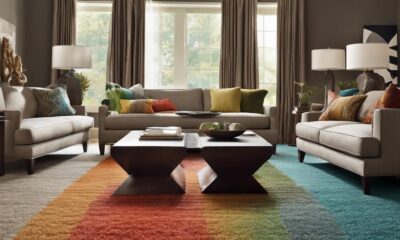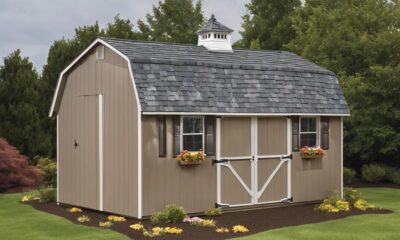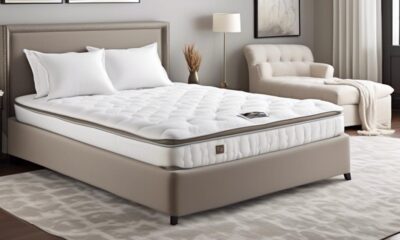Appliances
Why Does Ceiling Fan Hum
2025
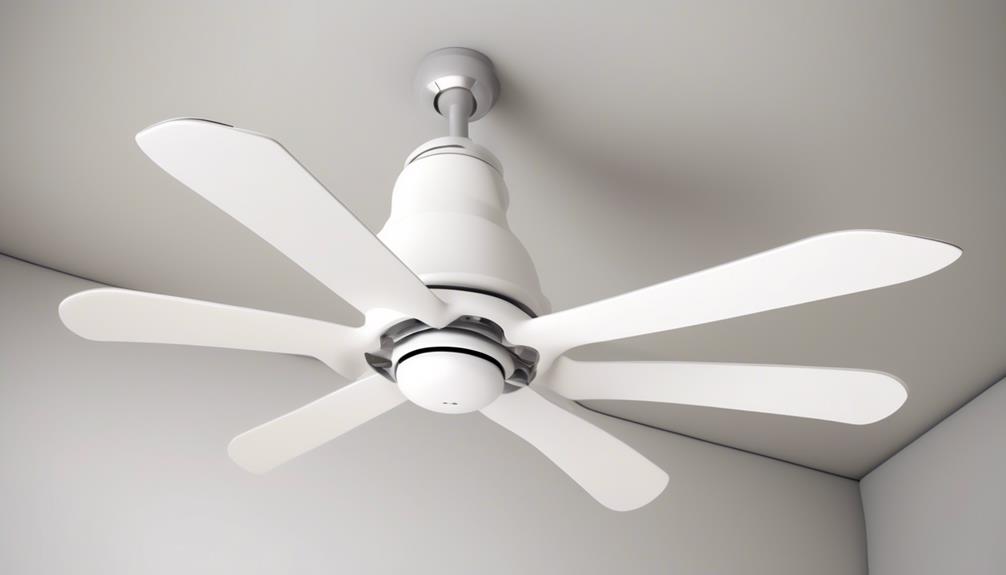
Ever found yourself in a tranquil space, attempting to relish the soft wind of your ceiling fan, when suddenly a bothersome buzzing noise disrupts the serenity?
It's as if a tiny orchestra has taken up residence in your living room, playing a continuous, off-key tune. But fear not, for we are here to unravel the mystery behind this perplexing phenomenon.
In this article, we will explore the various reasons why a ceiling fan may hum, from loose or misaligned blades to a poorly lubricated motor.
So sit back, relax, and let us guide you through the symphony of sounds that may be lurking above your head.
Key Takeaways
- Loose or misaligned fan blades, poorly lubricated fan motor, faulty capacitor, and faulty wiring connections are common causes of ceiling fan hum.
- Solutions for loose or misaligned fan blades include proper installation and maintenance, securing loose blades, and preventing vibrations and noise.
- Solutions for a poorly lubricated fan motor involve inspecting the motor for wear or damage, applying high-quality lubricant, and regular maintenance and lubrication.
- Solutions for a faulty capacitor include inspecting and testing the capacitor, replacing it if necessary, and consulting a professional electrician.
Loose or Misaligned Fan Blades
Loose or misaligned fan blades can cause a ceiling fan to emit a bothersome humming noise. This issue often arises due to improper fan installation or lack of regular maintenance. When the fan blades become loose or misaligned, they can create an uneven airflow, resulting in vibrations that produce the humming sound.
Improper fan installation is a common cause of loose or misaligned blades. If the fan isn't securely mounted or if the blades aren't properly attached, they can easily become loose and start vibrating. This can lead to the humming noise that you hear when the fan is running.
Another factor to consider is the impact of fan speed on the noise level. As you increase the fan speed, the vibrations caused by loose or misaligned blades become more pronounced, resulting in a louder humming noise. Conversely, reducing the fan speed can help minimize the vibrations and reduce the noise level.
To address this issue, it's important to ensure that the fan blades are securely attached during installation. Regular maintenance, such as checking for loose screws or bolts and realigning the blades if necessary, can also help prevent the problem. By addressing these factors, you can eliminate the bothersome humming noise and enjoy a smooth and quiet operation of your ceiling fan.
Poorly Lubricated Fan Motor
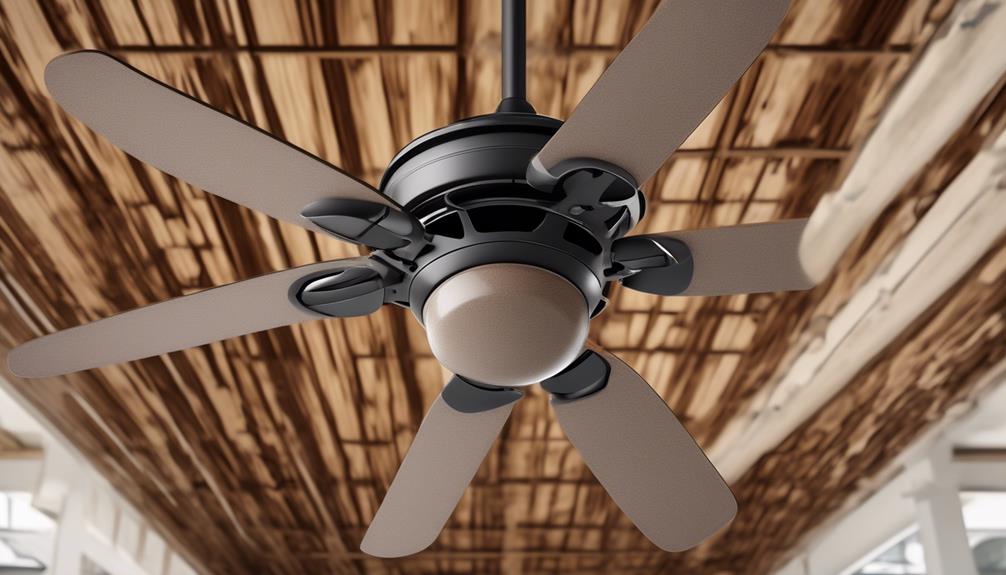
A poorly lubricated fan motor can contribute to the overall humming noise emitted by a ceiling fan. When the fan motor lacks sufficient lubrication, it can result in increased friction and resistance, leading to vibrations and noise. To address this issue, proper fan motor maintenance is essential.
Here are three key steps to troubleshoot fan motor noise caused by poor lubrication:
- Inspect the motor: Begin by turning off the fan and examining the motor assembly. Look for any signs of wear or damage, such as rust or excessive dirt accumulation. These can hinder the motor's performance and increase noise levels.
- Apply lubrication: Using a high-quality lubricant specifically designed for ceiling fan motors, carefully apply a few drops to the motor's bearings. Be sure to follow the manufacturer's instructions on the proper type and amount of lubricant to use. This will reduce friction and minimize noise caused by a poorly lubricated motor.
- Regular maintenance: To prevent future noise issues, establish a routine maintenance schedule. This should include periodic cleaning and lubrication of the fan motor. By properly maintaining the motor, you can extend its lifespan and ensure optimal performance.
Faulty Capacitor
When it comes to ceiling fan hum, one common culprit is a faulty capacitor. Capacitors are responsible for storing and releasing electrical energy, and when they malfunction, they can cause the fan to emit a humming noise.
Some common issues with capacitors include failure to start the fan, irregular speed control, and decreased overall performance.
Understanding these common capacitor issues can help diagnose and resolve the humming noise in ceiling fans.
Capacitor Malfunction Causes
One of the common causes of ceiling fan hum is a faulty capacitor. A capacitor is an essential component of the fan's motor, responsible for regulating the electrical current and providing the necessary power for its operation. When the capacitor malfunctions, it can lead to various issues, including the annoying humming sound.
To address this problem, there are a few capacitor repair options and troubleshooting steps you can take:
- Inspect the capacitor for any physical damage or leakage.
- Test the capacitor using a multimeter to check if it's faulty.
- Replace the faulty capacitor with a new one of the same specifications.
Humming Noise Explained
Our investigation into the source of the humming noise has revealed that a faulty capacitor is often to blame. When the capacitor in a ceiling fan becomes faulty, it can cause the fan to emit a humming sound. The capacitor is responsible for storing electrical energy and regulating the fan's speed.
Over time, capacitors can degrade or fail due to factors such as age, temperature fluctuations, or power surges. When a capacitor malfunctions, it can result in an imbalance in the electrical current flowing through the fan motor, leading to the humming noise. Additionally, improper fan blade alignment or loose electrical wiring can also contribute to the humming sound.
To fix the issue, it's recommended to replace the faulty capacitor or consult a professional electrician for assistance.
Common Capacitor Issues
Having identified the source of the humming noise as a faulty capacitor, it's important to understand the common issues associated with this component. Here are three common capacitor issues to be aware of:
- Capacitor Replacement: When a capacitor becomes faulty, it may need to be replaced. This involves selecting a replacement capacitor with the same specifications as the original one. It's crucial to ensure compatibility to avoid further damage to the ceiling fan.
- Troubleshooting Techniques: Troubleshooting techniques can help determine if the capacitor is indeed faulty. These techniques include using a multimeter to measure capacitance and checking for visual signs of damage, such as bulging or leaking.
- Correct Installation: Incorrect installation of a capacitor can lead to further issues. It's essential to follow the manufacturer's instructions carefully and ensure proper wiring and connections.
Understanding these common capacitor issues will enable you to effectively diagnose and resolve humming noises in ceiling fans. Remember to exercise caution and consult a professional if needed.
Loose Mounting Bracket
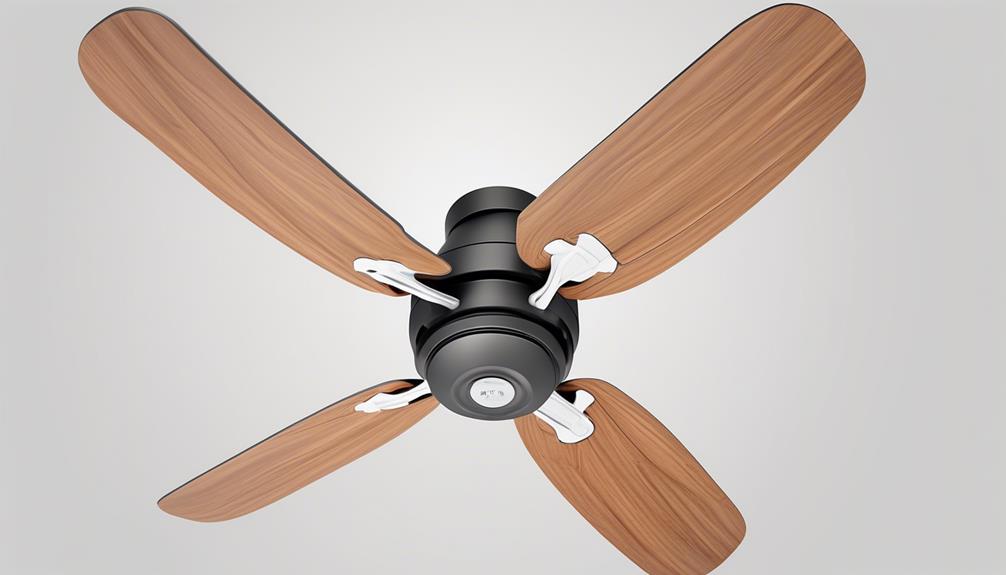
The stability of a ceiling fan can be compromised if the mounting bracket becomes loose. Improper maintenance or wear and tear over time can lead to a loose mounting bracket, which can result in various issues, including a humming sound. When the mounting bracket isn't securely fastened, it allows for movement and vibrations, causing the fan to produce an annoying humming noise. Additionally, a loose mounting bracket can lead to unbalanced airflow, causing the fan to wobble or shake.
To address a loose mounting bracket, it's important to first turn off the fan and ensure that the power supply is disconnected. Then, carefully inspect the mounting bracket for any signs of damage or looseness. If the bracket is loose, it may need to be tightened using the appropriate tools and hardware. It's crucial to follow the manufacturer's instructions and recommendations for tightening the mounting bracket to ensure proper installation.
Regular maintenance is essential to prevent a loose mounting bracket. Periodically check the tightness of the mounting screws and make any necessary adjustments. It's also advisable to inspect the mounting bracket during routine cleaning to identify potential issues early on.
Worn-out Ball Bearings
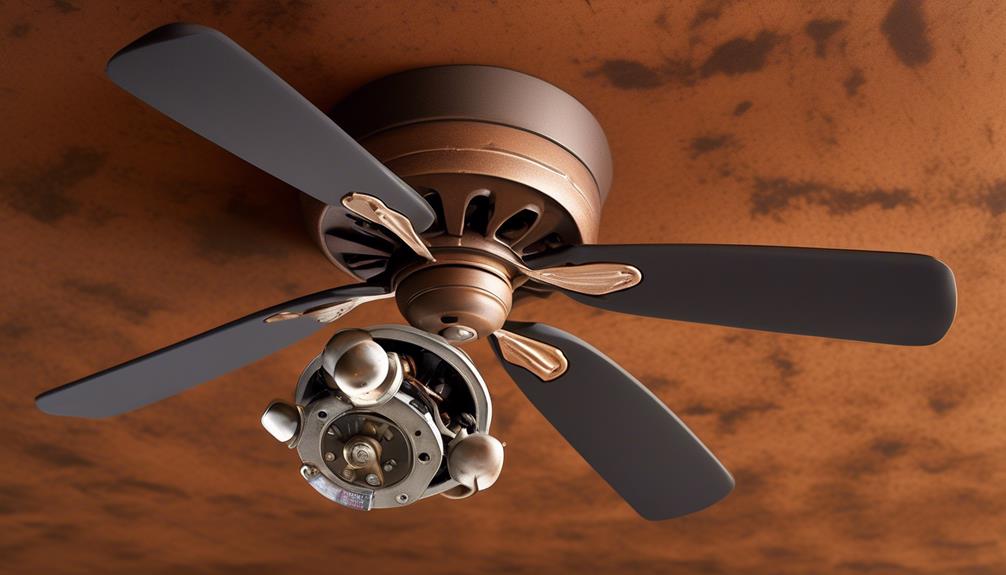
One possible cause of ceiling fan hum is worn-out ball bearings, which can result in excessive friction and noise during operation. When the ball bearings in a ceiling fan become worn-out, they can no longer provide the smooth rotation and stability needed for quiet operation. This can lead to a humming sound that can be quite annoying.
To troubleshoot this issue and restore the fan to its quiet state, there are a few steps you can take:
- Regular fan motor maintenance: Regularly lubricating the ball bearings can help prevent them from wearing out and reduce friction. This maintenance task should be performed as part of your routine fan maintenance.
- Inspection: Check the ball bearings for signs of wear or damage. Look for any excessive play in the fan's shaft or any grinding noises coming from the motor.
- Replacement: If the ball bearings are worn-out or damaged, they'll need to be replaced. Contact the manufacturer or a professional electrician to ensure you get the correct replacement parts and to assist with the installation.
Improper Installation
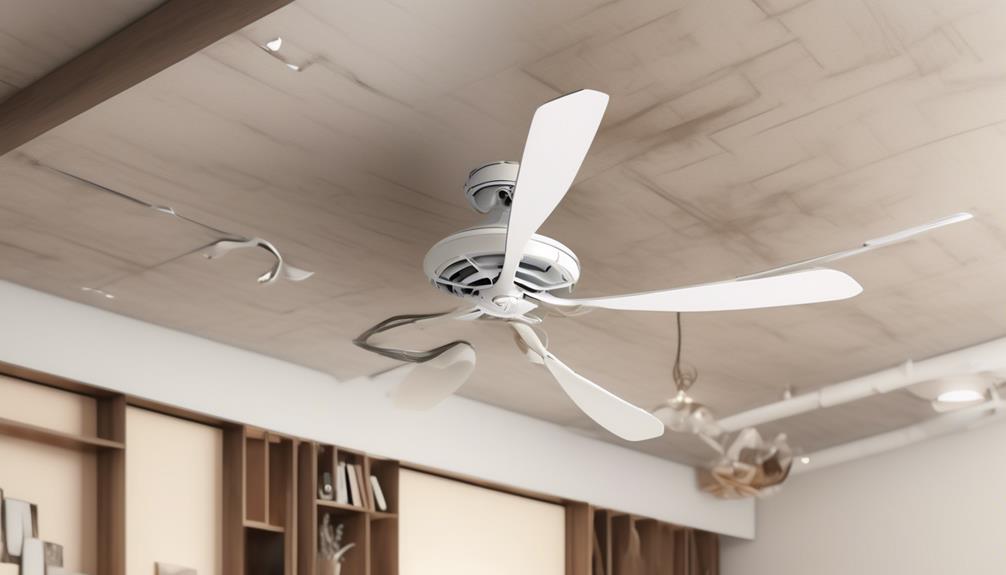
When it comes to the hum of a ceiling fan, improper installation can be a significant factor. Faulty wiring connections, such as loose or incorrect connections, can create electrical issues that contribute to the humming sound.
Additionally, incorrect blade alignment can cause the fan to vibrate and produce noise.
Lastly, loose mounting hardware can result in an unbalanced fan, leading to humming and rattling sounds.
Proper installation is crucial to ensure a quiet and efficient ceiling fan operation.
Faulty Wiring Connections
Faulty wiring connections in ceiling fan installations can lead to a humming noise when the fan is in operation. It's essential to troubleshoot wiring issues to ensure smooth and quiet fan operation. Here are some maintenance tips to address faulty wiring connections:
- Check for loose connections: Inspect the wiring connections between the fan and the electrical box. Tighten any loose screws or connectors to ensure a secure connection.
- Verify wire connections in the switch housing: Open the switch housing and examine the wire connections. Ensure that the wires are properly connected and tightly secured.
- Examine the wiring in the wall switch: If the fan is controlled by a wall switch, inspect the wiring connections at the switch. Make sure all connections are properly tightened and in good condition.
Incorrect Blade Alignment
To ensure proper fan operation and minimize noise, it's important to correctly align the blades during installation. Blade alignment issues can lead to vibrations and noise, which can be quite bothersome.
When the blades aren't aligned properly, they can create an imbalance in the fan, causing it to wobble and produce a humming sound. This issue can be resolved by adjusting the blades so that they're all at the same angle and distance from the ceiling.
Noise reduction techniques, such as using balancing kits or adjusting the blade pitch, can also be employed to minimize any humming or buzzing sounds.
Loose Mounting Hardware
Improper installation of a ceiling fan can result in loose mounting hardware, leading to potential issues with fan operation and increased noise levels.
When the mounting brackets become worn out or the fan canopy isn't securely fastened, the fan may start to vibrate or wobble, causing an annoying humming sound. This can be a frustrating experience for those seeking a peaceful and quiet environment.
To address this issue, it's essential to check the mounting brackets regularly and ensure they're in good condition. Additionally, make sure the fan canopy is tightly secured to prevent any unnecessary movement.
Electrical Issues
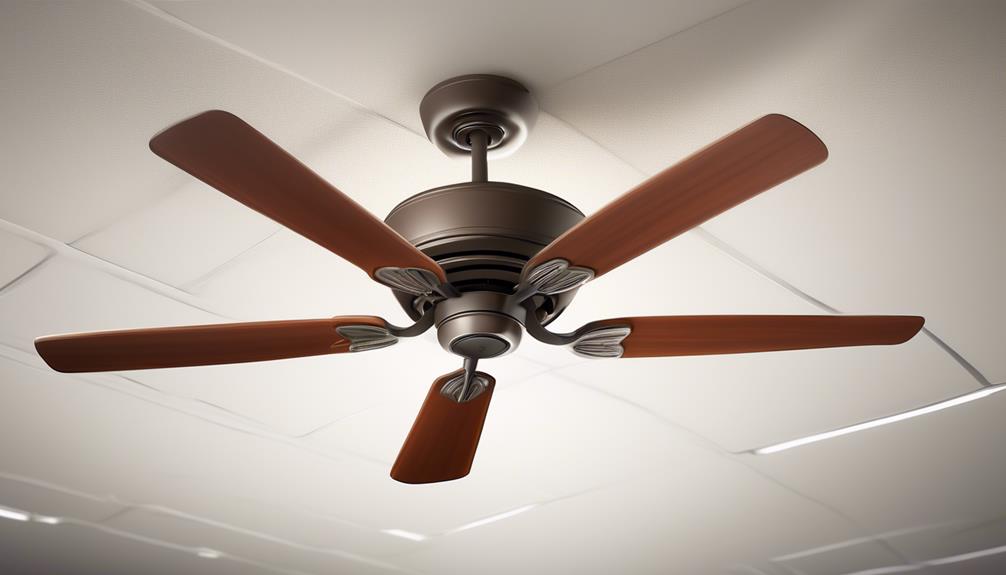
Sometimes, ceiling fans can emit a noticeable hum due to electrical issues. It's essential to understand and address these problems promptly to ensure the smooth operation and longevity of your ceiling fan. When dealing with electrical issues, it's crucial to prioritize electrical safety precautions. Before attempting any troubleshooting techniques, make sure to turn off the power to the fan at the circuit breaker. This will help prevent any potential electrical shocks or accidents.
One possible electrical issue that can cause a ceiling fan to hum is a loose connection. Over time, the electrical connections within the fan can become loose due to vibrations or wear and tear. To fix this, you'll need to remove the fan's canopy and inspect the wiring connections. Make sure all the connections are secure and tight. If you find any loose wires, gently tighten them using a screwdriver. Additionally, check the wires for any signs of damage or fraying. If you notice any, it's best to replace the affected wires to prevent further issues.
Another common electrical issue that may cause a ceiling fan to hum is a faulty capacitor. The capacitor helps regulate the fan's speed and can cause humming noises if it's defective. To troubleshoot this issue, you'll need to remove the fan's housing and locate the capacitor. Inspect the capacitor for any signs of bulging, leaking, or other damage. If you find any, it's recommended to replace the capacitor with a new one of the same specifications.
Dirty or Dusty Fan Blades
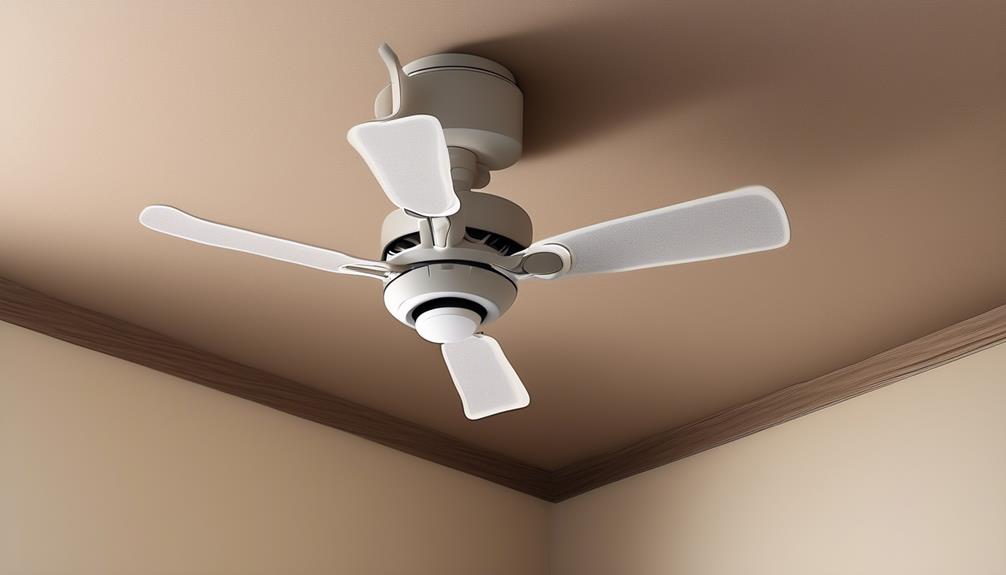
When it comes to ceiling fan hum, one common culprit is dirty or dusty fan blades. Dust accumulation on the blades can cause an imbalance, leading to vibrations and ultimately resulting in a humming noise.
The dirt on the blades can also create friction, which amplifies the humming sound.
Dust Accumulation Causes Hum
Dusty or dirty fan blades can accumulate dust, leading to a humming noise. To prevent this irritating issue, it's crucial to understand the importance of fan maintenance.
Here are three key points to consider:
- Regular cleaning: Dust and debris can build up on fan blades over time, causing the fan to operate less efficiently and produce noise. By regularly cleaning the blades, you can ensure smooth operation and prevent the accumulation of dust.
- Proper cleaning technique: When cleaning the fan blades, use a soft cloth or a feather duster to remove the dust gently. Avoid using water or harsh cleaning agents, as they may damage the blades or motor.
- Noise reduction techniques: In addition to cleaning, you can reduce fan noise by tightening loose screws, balancing the blades, or using noise-reducing accessories like rubber spacers or vibration dampeners.
Dirt on Blades Vibrates
To further explore the impact of dust accumulation on ceiling fan performance, let's now examine how dirt on the blades can cause vibrations and affect the operation of the fan. Dirty or dusty fan blades can disrupt the smooth rotation of the blades, resulting in vibrations that produce a humming noise. This can be quite bothersome, especially in rooms where a quiet environment is desired.
The accumulation of dirt on the blades can unbalance the fan, causing it to wobble and vibrate. Over time, this can lead to excessive wear and tear on the motor and other components, potentially shortening the lifespan of the fan.
To prevent this issue, regular maintenance of the blades is essential. Cleaning the blades with a damp cloth or a soft brush can remove the accumulated dirt and dust. It's important to ensure that the fan is turned off before attempting any cleaning or maintenance to avoid accidents.
Unbalanced Fan Blades
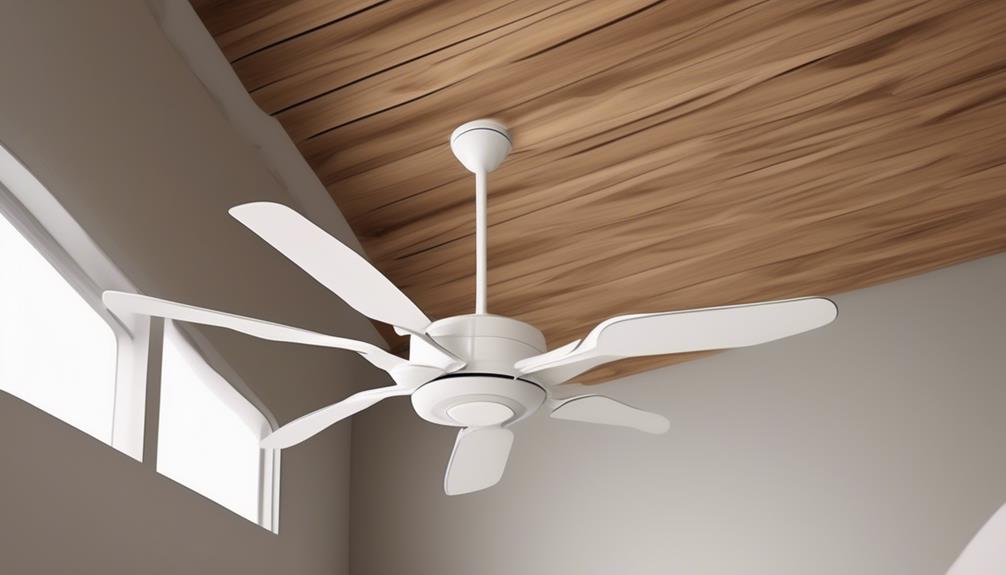
Occasionally, ceiling fans may produce a humming noise due to unbalanced fan blades. When the blades aren't evenly distributed around the fan's center of gravity, it can lead to blade imbalance. This imbalance causes the fan to vibrate, resulting in the humming noise that can be quite annoying.
To better understand the issue, let's explore three key factors related to unbalanced fan blades:
- Weight distribution: Unequal weight distribution among the fan blades can cause an imbalance. This can occur due to manufacturing defects or accumulation of dust and dirt over time.
- Blade alignment: Improper alignment of the fan blades can also contribute to an imbalance. If the blades aren't aligned correctly, it can lead to uneven airflow and vibration.
- Motor lubrication: Another factor that can affect the balance of fan blades is the condition of the motor. Lack of proper lubrication can cause the motor to work harder, resulting in increased vibration and noise.
To address blade imbalance, it's essential to ensure that the fan blades are clean and free from any debris. Regular maintenance, including proper motor lubrication, can help minimize the occurrence of unbalanced fan blades and reduce the humming noise.
Incompatible Dimmer Switch
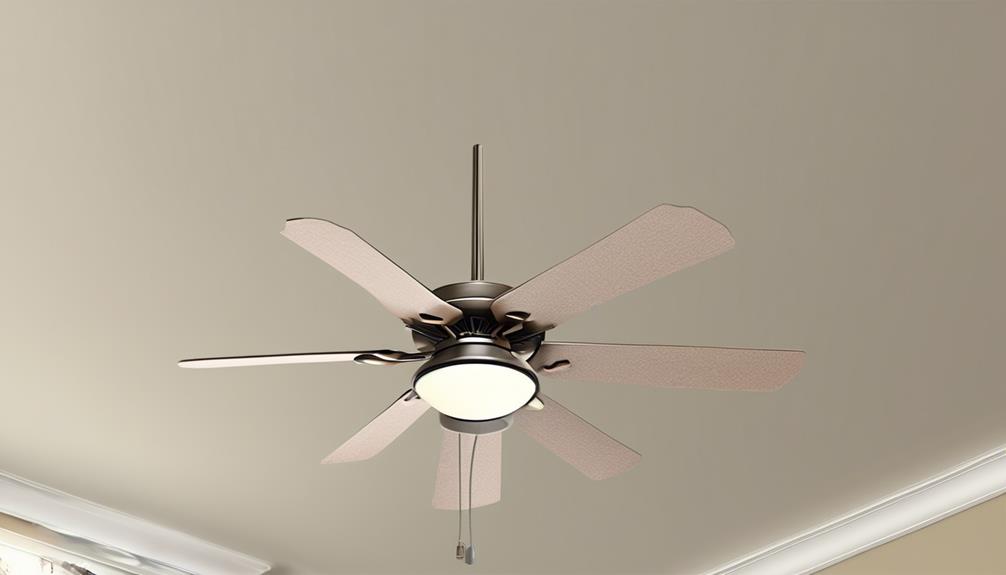
An incompatible dimmer switch can contribute to the humming noise produced by a ceiling fan. It's important to ensure dimmer switch compatibility with the fan to avoid this issue. Dimmer switches are designed to control the brightness of lights, but when used with ceiling fans, they can create electrical interference that results in the humming sound. This is because dimmer switches aren't specifically designed for motorized devices like ceiling fans. When a dimmer switch is incompatible, it can cause the fan's motor to vibrate and produce noise.
To resolve this problem, it's recommended to use a dedicated fan speed control switch instead of a dimmer switch. These switches are specifically designed for controlling the speed of ceiling fans and don't cause electrical interference or produce humming noise.
Additionally, regular lubrication maintenance can also help reduce the humming noise caused by an incompatible dimmer switch. Proper lubrication of the fan's motor and bearings ensures smooth operation and minimizes friction, which can contribute to the humming sound.
Vibrations From Ceiling or Wiring
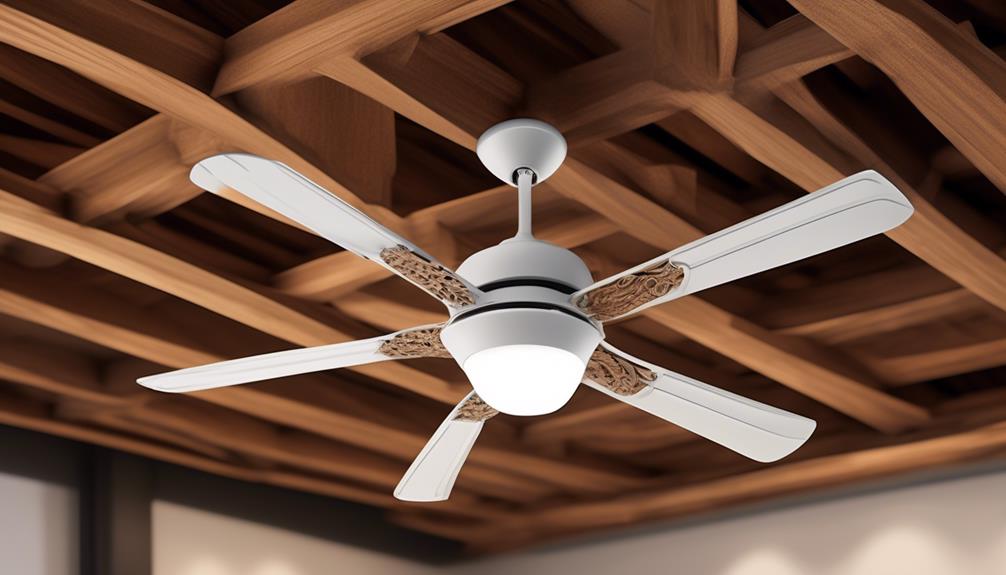
When addressing the issue of ceiling fan hum, it's crucial to consider the potential vibrations that may arise from the ceiling or wiring. These vibrations can contribute to the noise produced by the fan and can be quite bothersome.
Here are three key factors related to vibrations from the ceiling or wiring that can affect the performance of your ceiling fan:
- Ceiling material: The type of material used for your ceiling can impact the vibrations transmitted to the fan. For example, if you have a plaster ceiling, it may be more prone to vibrations compared to a ceiling made of concrete or wood.
- Installation: Improper installation of the ceiling fan can lead to vibrations. If the fan isn't securely attached to the ceiling or if any of the mounting components are loose, it can cause the fan to vibrate and produce humming noises.
- Wiring: The wiring of the fan can also contribute to vibrations. If the wiring isn't properly secured or if there are loose connections, it can result in vibrations that can be transferred to the fan. Additionally, if the wiring is too close to the fan motor, it can cause interference and lead to unwanted vibrations.
To minimize vibrations from the ceiling or wiring, ensure that the fan is properly installed, the mounting components are secure, and the wiring is correctly positioned and secured. By addressing these factors, you can reduce the chances of vibrations and ultimately minimize the annoying hum produced by your ceiling fan.
Age and Wear of the Fan
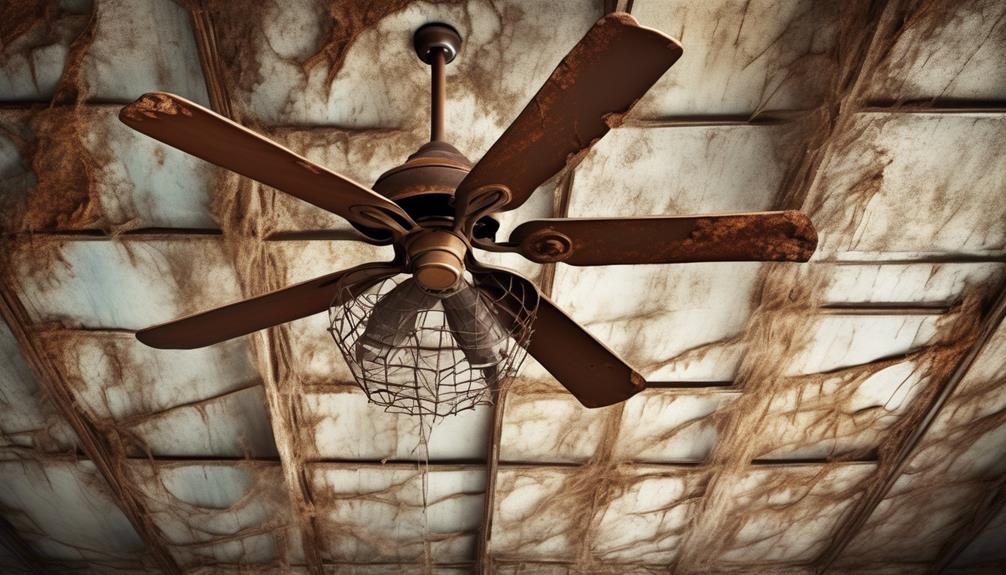
Age and wear can significantly impact the performance and noise level of a ceiling fan. As a fan ages, it may develop various age-related problems that can affect its functionality. Additionally, the wear and tear on the fan's components can lead to increased noise levels. To ensure optimal performance and minimize noise, regular maintenance is essential.
Maintenance requirements for ceiling fans vary depending on their age and condition. It is important to inspect the fan regularly for any signs of wear or damage. This includes checking the blades, motor, and mounting brackets for any loose or worn parts. Lubricating the motor bearings and cleaning the fan blades can also help reduce noise caused by friction.
In some cases, age-related problems may require more extensive repairs or even the replacement of certain components. For example, if the motor is worn out or the blades are damaged beyond repair, these parts may need to be replaced to restore the fan's performance.
To better understand the impact of age and wear on ceiling fan performance, consider the following table:
| Age-related Problems | Maintenance Requirements |
|---|---|
| Worn-out motor | Replacement required |
| Damaged blades | Replacement or repair |
| Loose mounting | Tightening or realignment |
Is a Humming Ceiling Fan a Sign of a Potential Buzzing Issue?
If you’re experiencing a humming ceiling fan, it could be a sign of potential buzzing issues. Several ceiling fan noise causes may be the culprit, such as loose parts, unbalanced blades, or motor problems. It’s important to address the issue promptly to prevent further damage and maintain a peaceful environment.
Frequently Asked Questions
Can a Ceiling Fan Hum Because of an Issue With the Remote Control?
Yes, a ceiling fan can hum due to an issue with the remote control.
When troubleshooting ceiling fan humming, it's important to first check the remote control.
Ensure that the batteries aren't low or dead, as this can cause the fan to make unusual noises.
Additionally, make sure that the remote control is properly synced with the fan.
If the issue persists, it may be necessary to contact a professional for further assistance with ceiling fan remote troubleshooting.
Is It Normal for a Ceiling Fan to Make a Humming Noise When It's on High Speed?
When a ceiling fan is on high speed, it's normal for it to make a humming noise. However, if the noise becomes too loud or bothersome, there are ways to reduce it.
Common reasons for ceiling fan humming include loose screws, unbalanced blades, or worn-out bearings. To fix these issues, tighten all the screws, balance the blades, and lubricate the bearings.
Additionally, using a rubber or foam pad between the fan and the ceiling can also help reduce the noise.
Can a Ceiling Fan Hum Because of Interference From Other Electronic Devices in the Room?
Sometimes, a ceiling fan can hum due to interference from other electronic devices in the room. This can happen when the electrical signals from these devices interact with the fan's motor, causing a disturbance in its operation.
It's important to note that not all electronic devices will cause interference, but certain ones, such as Wi-Fi routers or poorly shielded appliances, can potentially affect the fan's performance.
To avoid this, try repositioning or relocating the fan away from these devices to reduce the chances of interference.
Can a Ceiling Fan Hum Because of a Power Surge or Electrical Problem in the House?
A ceiling fan can indeed hum due to a power surge or electrical problem in the house. These issues can cause the motor to vibrate, resulting in an annoying hum.
To troubleshoot and fix a humming ceiling fan, it's important to check the electrical connections and ensure they're secure.
Additionally, using a voltage regulator or surge protector can help prevent power surges that may cause the fan to hum.
Regular maintenance and cleaning can also reduce the chances of a humming fan.
Is It Possible for a Ceiling Fan to Hum Because of a Problem With the On/Off Switch?
It is possible for a ceiling fan to hum due to a problem with the on/off switch. When the switch is faulty, it can cause the fan motor to vibrate, resulting in a humming noise.
Additionally, faulty wiring can also contribute to the humming sound. It's important to have a qualified electrician inspect and repair any issues with the switch or wiring to ensure proper functioning and eliminate the humming noise.
Conclusion
In conclusion, the humming of a ceiling fan can be attributed to various factors such as:
- Loose blades
- Insufficient lubrication
- Faulty capacitors
- Worn-out bearings
It can also result from:
- An unbalanced fan
- Incompatible dimmer switch
Vibrations from the ceiling or wiring can contribute to the noise as well. Additionally, the age and wear of the fan can play a role. Understanding these causes allows for effective troubleshooting and maintenance, ensuring a quiet and efficient fan operation.
- About the Author
- Latest Posts
Introducing Ron, the home decor aficionado at ByRetreat, whose passion for creating beautiful and inviting spaces is at the heart of his work. With his deep knowledge of home decor and his innate sense of style, Ron brings a wealth of expertise and a keen eye for detail to the ByRetreat team.
Ron’s love for home decor goes beyond aesthetics; he understands that our surroundings play a significant role in our overall well-being and productivity. With this in mind, Ron is dedicated to transforming remote workspaces into havens of comfort, functionality, and beauty.
Garage Door Opener
How to Program Your MVP Garage Door Opener Remote
Uncover the secrets of programming your MVP Garage Door Opener remote with precision and patience, unlocking a world of possibilities.

When you’re setting up your MVP Garage Door Opener remote, think of it as giving your car keys the power to unlock endless possibilities. But how can we make sure this process is smooth and efficient every time?
Well, there's a method to the madness that involves precision and patience. Let's unravel the mysteries of syncing your remote with the garage door opener, troubleshooting any glitches, and perhaps discovering some insider tips that could make your garage access a breeze.
Key Takeaways
- Prepare the remote and enter programming mode with designated button sequences.
- Sync the remote and opener by inputting a 9-digit code for secure connectivity.
- Test the remote by sending signals to ensure seamless garage door control.
- Troubleshoot issues like unresponsiveness or non-functional buttons for effective remote programming.
Remote Preparation
To prepare the MVP Garage Door Opener remote for programming, we must first ensure it's in programming mode by pressing the designated buttons. The remote features three buttons: the + button, the – button, and the opener button. Pressing the + button followed by the – button puts the remote into programming mode.
Once in programming mode, you can proceed with assigning the opener button for the garage door. This button will be used to activate the garage door opener. After selecting the opener button, input a 9-digit code using the remote to link it to your garage door opener. This step is crucial for establishing a secure connection between the remote and the garage door opener.
Accessing Programming Mode

To access programming mode on the MVP Garage Door Opener, hold down the + button until the LED light flashes. This indicates that the unit is ready for programming. Once the LED light starts flashing, you can proceed with setting up your remote for use with the garage door opener. To give you a clearer picture, let's take a look at the following table:
| Button Action | LED Response | Wall Mount |
|---|---|---|
| Hold + Button | LED light flashes | Wall mount secure |
| Press – Button | Select programming | Wall mount stable |
| Enter 9-digit code | Sync remote | Wall mount aligned |
Syncing With Garage Door Opener
After successfully accessing programming mode by holding down the + button until the LED light flashes, the next step is syncing the MVP Garage Door Opener remote with the garage door opener.
To sync, press and hold the + button on the remote, then press the – button to enter programming mode. Once in programming mode, select a button on the remote to link with the garage door opener and input the provided 9-digit code.
The LED on the remote will flash, indicating successful syncing with the garage door opener. This process ensures that the remote is now paired and ready for use.
Syncing the remote allows for seamless communication between the remote and the garage door opener, enabling you to conveniently control the garage door with a simple button press. Proper syncing is crucial for the remote to function effectively, providing you with the freedom to operate your garage door effortlessly.
Testing the Remote

Testing the remote involves pressing the + button on the handheld device to ensure the MVP garage door opener functions correctly. To properly test the MVP garage door opener remote, follow these steps:
- Check the LED Light: Press the + button on the remote and ensure that the LED light on the device illuminates. This indicates that the remote is sending a signal to the garage door opener.
- Observe the Door Opening: After pressing the button, observe the garage door to ensure it responds to the signal from the remote. The door should start opening, confirming that the remote is effectively controlling the opener.
- Multiple Tests for Verification: To confirm the smooth functioning of the MVP garage door opener, test the remote multiple times. This ensures consistency and reliability in controlling the garage door.
Troubleshooting and Tips
For optimal troubleshooting and useful tips when working with your MVP Garage Door Opener remote, it is essential to understand common issues and effective solutions. If you encounter problems during programming, ensure that the LED on the remote flashes when in programming mode. Confirm successful programming by inputting the 9-digit code and testing the remote's functionality. If you face difficulties, consult the manual, online resources, or seek professional help. Consider purchasing a new remote if reprogramming attempts fail to ensure smooth garage door operation.
| Common Issues | Solutions |
|---|---|
| Remote not responding | Check battery levels and reprogram if needed |
| LED not flashing in programming | Replace batteries and retry programming mode |
| Button not working | Clean the button or consider replacing the remote with a new one |
Frequently Asked Questions
How Do I Program My MVP Remote?
To program your MVP remote, follow these steps:
- Press and hold the + button, then the – button to enter programming mode.
- Select the desired button and input the 9-digit code provided.
- Link the remote to one or multiple garage door openers for convenience.
The process is straightforward: enter the code and choose the operational button. This method ensures seamless functionality for your MVP garage door opener remote.
Where Is the Learn Button on My MVP Garage Door Opener?
The learn button on your MVP Garage Door Opener is typically situated near the antenna wire on the motor unit. This small, often round button, available in various colors like red or yellow, is pivotal for programming your opener.
Pressing this button puts the opener into programming mode, enabling you to sync new remotes or reprogram existing ones. The learn button's accessibility is key for smooth programming and convenience.
How Do I Reprogram My Garage Door Remote?
We reprogram garage door remotes by entering programming mode and linking a button to the opener.
A 9-digit code is input for programming. The MVP opener is versatile, able to work with multiple remotes. Security is ensured with over 19,000 preprogrammed codes.
Successful programming is indicated by the red LED light, and confirmation is given by releasing buttons after 5 seconds.
Testing functionality ensures proper operation post-reprogramming.
How Do I Pair My Garage Door Remote?
We pair our garage door remote by pressing and holding the + button to enter programming mode.
Then, we input a unique 9-digit code by pressing the desired button on the remote.
Once the LED indicator flashes, we know programming was successful.
To test, we press the programmed button to operate the garage door.
Pairing the remote offers convenient and secure access to our garage, enhancing our overall experience.
Conclusion
In conclusion, programming your MVP Garage Door Opener remote is as crucial as calibrating a precision instrument. By following the outlined steps meticulously, you can ensure seamless operation and enhanced security for your garage.
Just like a well-oiled machine, your remote will now function flawlessly, providing you with convenient access to your garage whenever needed.
- About the Author
- Latest Posts
Introducing Ron, the home decor aficionado at ByRetreat, whose passion for creating beautiful and inviting spaces is at the heart of his work. With his deep knowledge of home decor and his innate sense of style, Ron brings a wealth of expertise and a keen eye for detail to the ByRetreat team.
Ron’s love for home decor goes beyond aesthetics; he understands that our surroundings play a significant role in our overall well-being and productivity. With this in mind, Ron is dedicated to transforming remote workspaces into havens of comfort, functionality, and beauty.
Garage Door Opener
Craftsman Garage Door Opener Battery Backup Installation Guide
Dive into the essential steps for installing the Craftsman Garage Door Opener Battery Backup to safeguard your garage access in critical moments.

Let’s address the installation of the Craftsman Garage Door Opener Battery Backup in a systematic manner.
As we navigate through the intricacies of setting up this essential backup system, we'll uncover key insights that can make all the difference in ensuring a seamless integration.
Stay tuned as we unravel the nuances of this process, shedding light on crucial steps that could be the game-changer in safeguarding your garage access during unforeseen situations.
Key Takeaways
- LED lights indicate battery status for seamless operation
- Replacement batteries available for around $90 from Sears
- Troubleshooting may involve battery replacement for functionality
- Understanding system intricacies crucial for uninterrupted operation
Battery Backup System Overview
When considering the Battery Backup System Overview for the Craftsman garage door opener, it's essential to understand its fundamental role in ensuring uninterrupted operation during power outages. The battery backup system is a crucial component of the Craftsman garage door opener, providing power during outages to maintain continuous functionality.
LED lights on the opener display different colors to indicate the battery status, with green signaling normal operation and red indicating error detection. This feature significantly enhances the reliability and performance of the garage door opener, especially during power disruptions.
Sears offers replacement batteries specifically designed for the Craftsman garage door opener, with replacements typically priced around $90. Troubleshooting the battery backup system may involve replacing the battery if indicated as faulty, following Sears' installation guidance to ensure proper functioning.
Understanding the intricacies of the battery backup system is vital for ensuring the seamless operation of the Craftsman garage door opener during power outages.
Required Tools and Materials

To successfully install the Craftsman garage door opener battery backup, gather essential tools such as a screwdriver, ladder, and possibly a drill for mounting, along with specific materials like the battery backup unit, mounting brackets, screws, and wiring harness. When preparing for the installation, it's crucial to ensure you have the following tools and materials ready:
- Screwdriver: Necessary for removing panels and securing components during the installation process.
- Ladder: Used to access and work on the garage door opener system safely at elevated heights.
- Drill: Optional but may be needed for mounting the battery backup unit securely in place.
- Mounting Brackets, Screws, and Wiring Harness: These are essential components for attaching the battery backup unit to the garage door opener and connecting it effectively.
Before beginning the installation, always prioritize safety precautions by disconnecting power sources and following the manufacturer's guidelines meticulously to prevent any accidents.
Step-by-Step Installation Instructions
Let's begin with the step-by-step installation instructions for integrating the Craftsman Garage Door Opener battery backup system. Follow these detailed steps to ensure a smooth installation process:
Craftsman Garage Door Opener Battery Backup Installation Steps:
| Steps | Actions | Tips |
|---|---|---|
| Step 1 | Turn off the power to the garage door opener. | Ensure safety by disconnecting the power source. |
| Step 2 | Locate the motor unit of the garage door opener. | The backup battery will be connected here. |
| Step 3 | Connect the backup battery to the motor unit. | Follow the provided instructions for proper installation. |
| Step 4 | Check the LED lights on the opener to verify battery status. | Green light indicates full charge; red light signals low battery. |
| Step 5 | Test the garage door opener with the backup battery. | Ensure seamless functionality during a power outage. |
Testing and Troubleshooting

We'll now proceed to assess the functionality of the Craftsman Garage Door Opener battery backup system through a series of tests and troubleshooting procedures.
- Check LED Lights: Look at the LED lights on the garage door opener. Green indicates normal operation, yellow signals backup power engagement, and red suggests an error requiring service.
- Test Keypad Codes: Ensure you're using the correct keypad codes for both the wall mount opener and the remote to operate the garage door.
- Inspect Trolley Engagement: If the trolley disengages due to power loss, re-engage it according to the manufacturer's instructions.
- Red Light Indicator: If the red light persists after troubleshooting, contact a professional for service on the garage door opener.
Maintenance Tips and Safety Precautions
Inspecting and lubricating the moving parts regularly ensures smooth operation and extends the longevity of your Craftsman Garage Door Opener. To maintain optimal performance and safety, keep the photo-eye sensors clean and properly aligned for the safety reversal system to function correctly. Periodically test the battery backup system to ensure it is ready for any power outages. Check for any loose hardware and tighten as needed to prevent accidents or malfunctions. It is essential to schedule professional maintenance at least once a year to address any potential issues and ensure the garage door opener operates efficiently.
| Maintenance Tips and Safety Precautions | ||
|---|---|---|
| 1. Inspect and lubricate moving parts | 2. Clean and align photo-eye sensors | 3. Test battery backup system |
| Regular inspection and lubrication keep the garage door opener running smoothly. | Ensure sensors are clean and aligned for proper safety function. | Verify battery backup readiness for power outages. |
| 4. Check for loose hardware | 5. Schedule professional maintenance | |
| Tighten any loose hardware to prevent accidents. | Annual maintenance ensures optimal performance. |
Frequently Asked Questions
How Do You Replace a Craftsman Garage Door Opener Battery?
We start by replacing a Craftsman garage door opener battery by checking the LED lights for status:
- Green for normal,
- Yellow for backup,
- Red for error.
We then proceed to purchase a replacement battery for about $90. We can find these batteries and installation guidance from Sears.
Common issues that may signal the need for battery replacement include:
- Trouble closing the door,
- Specific keypad codes,
- Trolley disengagement,
- A red service light.
Can You Add a Battery Backup to an Existing Garage Door Opener?
Yes, we can add a battery backup to an existing garage door opener. It's a simple upgrade that ensures seamless operation during power outages.
How Do You Install a Garage Backup Battery?
When installing a garage backup battery, we begin by ensuring the power is disconnected for safety.
Then, locate the designated terminals on the garage door opener and securely mount the battery.
Connect the battery to the terminals following the manufacturer's instructions carefully.
Test the backup battery regularly to confirm it's charged and ready to provide power during outages.
This will ensure uninterrupted operation of the garage door opener when needed.
Is Garage Door Opener Battery Backup Worth It?
Absolutely, having a garage door opener battery backup is totally worth it! It ensures continuous access to your garage, even during power outages, offering both convenience and security.
With seamless operation and no manual intervention required, the peace of mind it provides is priceless. The investment in a battery backup system for your garage door opener is a smart choice for anyone seeking uninterrupted accessibility in emergency situations.
Conclusion
In conclusion, installing a Craftsman garage door opener battery backup is a smart investment for ensuring your garage door operates smoothly even during power outages.
Did you know that 70% of homeowners experience at least one power outage every year? By following the step-by-step guide provided, you can easily set up your battery backup system and enjoy peace of mind knowing your garage door will always be functional.
- About the Author
- Latest Posts
Introducing Ron, the home decor aficionado at ByRetreat, whose passion for creating beautiful and inviting spaces is at the heart of his work. With his deep knowledge of home decor and his innate sense of style, Ron brings a wealth of expertise and a keen eye for detail to the ByRetreat team.
Ron’s love for home decor goes beyond aesthetics; he understands that our surroundings play a significant role in our overall well-being and productivity. With this in mind, Ron is dedicated to transforming remote workspaces into havens of comfort, functionality, and beauty.
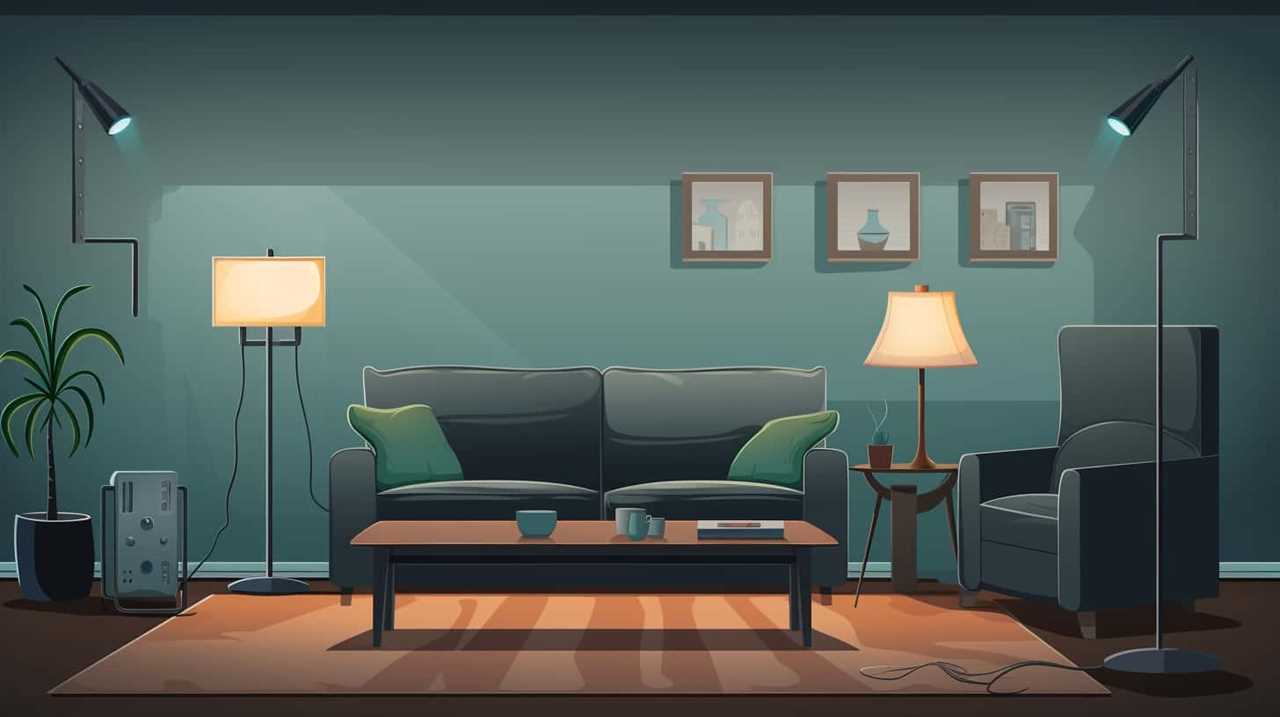
In the realm of cooking, we understand the importance of having the proper tools at your disposal. Just like the saying, ‘a chef’s skills are only as good as their equipment.’ That’s why we have compiled a list of 10 clever kitchen gadgets that every home cook should have.
These innovative devices are designed to elevate your cooking experience and bring a touch of mastery to your culinary creations. From a smart refrigerator with a touchscreen display to a voice-controlled smart oven, these gadgets combine functionality and convenience in ways you never thought possible.
So, let’s dive in and discover the game-changing gadgets that are about to revolutionize your kitchen.
Key Takeaways
- Smart kitchen gadgets for coffee lovers offer customizable brewing options and remote brewing capabilities, making the coffee brewing process simplified and enhanced.
- Smart kitchen gadgets for precision cooking, such as smart sous vide precision cookers and programmable pressure cookers, ensure consistent and precise cooking results without constant monitoring.
- Smart kitchen gadgets for meal planning and organization, like app-controlled slow cookers and blenders, save time in monitoring and controlling the cooking process and make grocery shopping and meal preparation more efficient.
- Smart kitchen gadgets enhance cooking skills by elevating the home brewing and cooking experience to a professional level, ensuring recipe accuracy and consistency, and allowing for customization of cooking settings based on personal preferences.
Smart Refrigerator With Touchscreen Display
Our favorite feature of the smart refrigerator is its touchscreen display, which allows us to easily access and organize our groceries. With the integration of touchscreen technology, this interactive kitchen appliance revolutionizes the way we manage our food inventory.
The touchscreen display provides a user-friendly interface that enables us to effortlessly navigate through the refrigerator’s various features and functions. We can view our groceries at a glance, making it convenient to check what items we’ve and what needs to be restocked. The display also allows us to create shopping lists directly on the screen, ensuring that we never forget an essential ingredient again.
Furthermore, the interactive nature of the touchscreen allows us to customize settings according to our preferences. We can adjust temperature controls, select specific storage zones for different food items, and even set expiration reminders to minimize food waste. The smart refrigerator also offers recipe suggestions based on the ingredients available, making meal planning easier and more efficient.
In terms of design, the touchscreen display seamlessly blends with the aesthetics of the refrigerator, enhancing the overall visual appeal of our kitchen. Its intuitive interface and sleek appearance make it a desirable addition to any modern home.
Voice-Controlled Smart Oven
We love using our voice-controlled smart oven to effortlessly cook our favorite meals. This innovative kitchen gadget combines the convenience of voice control with advanced automation features, making it an essential tool for any home chef. With just a simple voice command, we can easily preheat the oven, adjust the temperature, set timers, and even check the cooking progress without lifting a finger.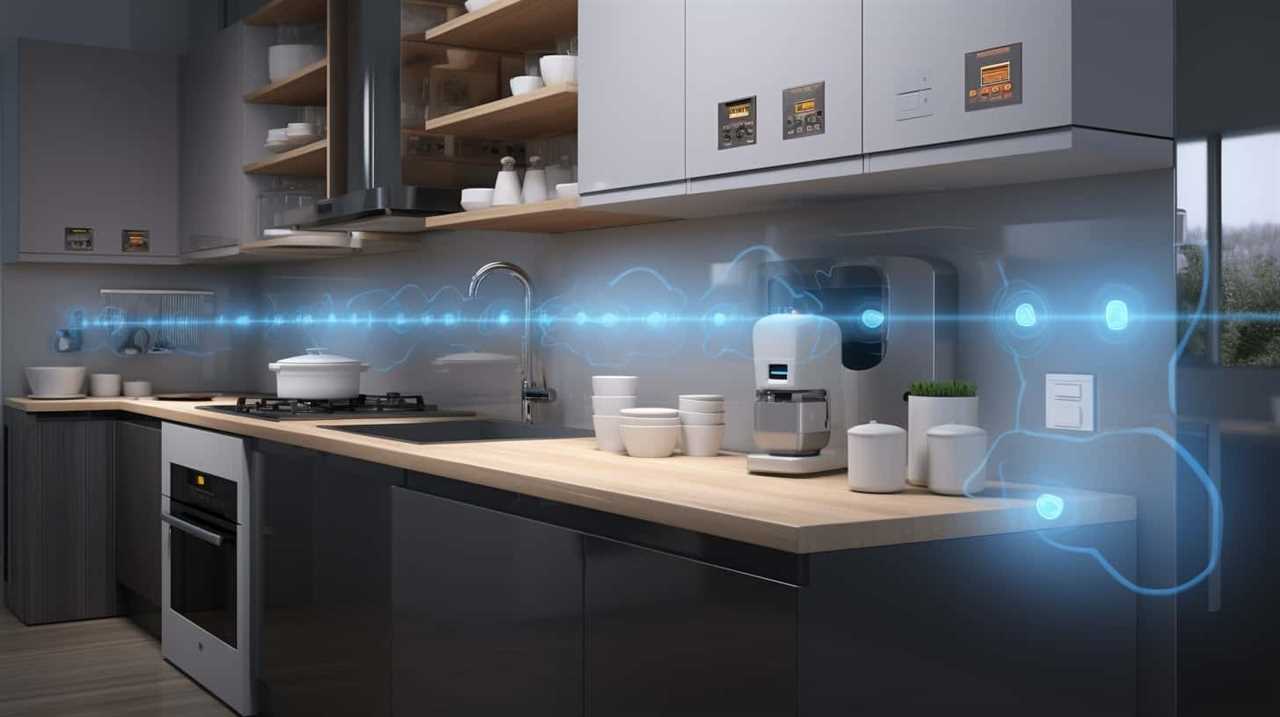
The automation benefits of a voice-controlled oven are truly remarkable. It saves us time and effort by eliminating the need to manually operate the oven. We can multitask in the kitchen or attend to other chores while our meal bakes to perfection. The table below highlights some of the key features and advantages of a voice-controlled smart oven:
| Features | Advantages |
|---|---|
| Voice control | Hands-free operation for a seamless cooking experience |
| Temperature control | Precise heat adjustment for consistent results |
| Timer setting | Set timers and receive alerts for perfect timing |
A voice-controlled smart oven takes cooking to a whole new level of convenience and efficiency. It empowers us to effortlessly create delicious meals while enjoying the benefits of automation. Whether we are busy professionals or culinary enthusiasts, this smart kitchen gadget is a must-have for those who seek mastery in the art of cooking.
Wi-Fi Enabled Smart Coffee Maker
We all know that a good cup of coffee is essential to kickstart our day. A Wi-Fi enabled smart coffee maker can take our coffee experience to the next level. With the benefits of automation, we can wake up to the aroma of freshly brewed coffee without lifting a finger.
But that’s not all – the remote brewing capabilities allow us to start brewing our coffee from anywhere in our home. This ensures that our cup of joe is ready when we need it.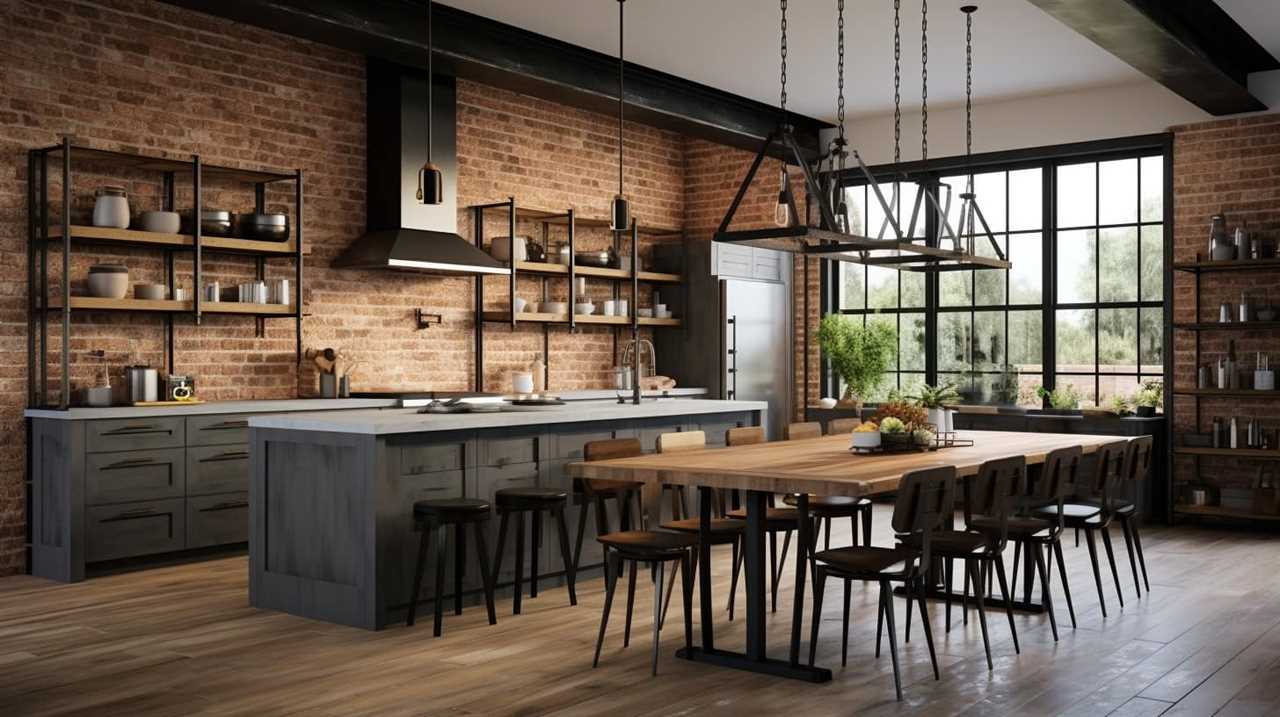
And with customizable brewing options, we can personalize our coffee strength and flavor to suit our preferences.
Benefits of Automation
The convenience of automation is one of the key advantages offered by a Wi-Fi enabled smart coffee maker. With this innovative gadget, you can easily set your coffee to start brewing at a specific time, ensuring you wake up to the aroma of freshly brewed coffee.
Here are some benefits of automation in the kitchen:
- Time-saving: Automation allows you to focus on other tasks while your coffee maker takes care of brewing your favorite cup of joe.
- Customization: With a smart coffee maker, you can easily adjust the strength, temperature, and even the size of your coffee, ensuring it perfectly suits your preferences.
Automation in the kitchen, such as a Wi-Fi enabled smart coffee maker, is just one example of how technology has impacted cooking skills. It simplifies and enhances the coffee brewing process, giving home chefs more control and convenience.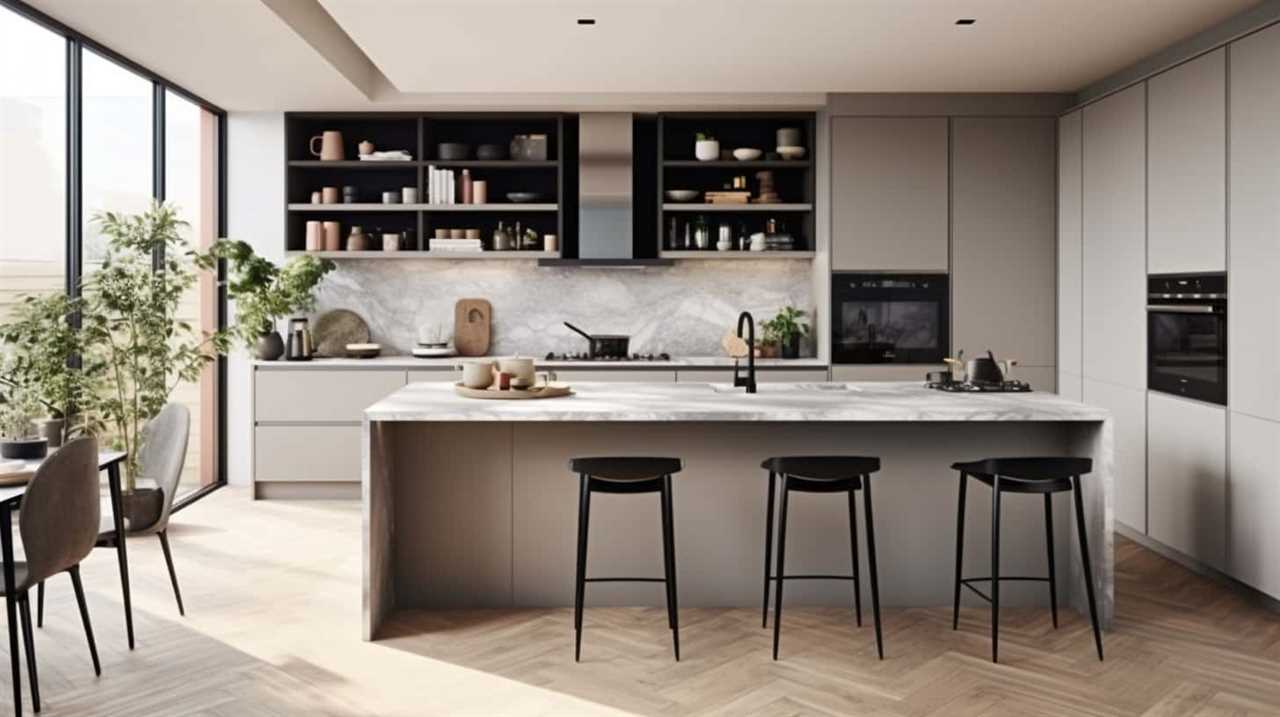
As technology continues to evolve, we can expect even more innovative gadgets that will revolutionize the way we cook and enjoy our meals.
Remote Brewing Capabilities
Using the convenience of a time preposition, our smart coffee maker allows us to remotely brew a perfect cup of coffee from anywhere in the house. Imagine waking up in the morning and being able to start brewing your favorite cup of joe without even leaving your bed. With customizable recipes and remote temperature control, our smart coffee maker provides the ultimate brewing experience.
Take a look at the table below to see the features of our Wi-Fi enabled smart coffee maker:
| Feature | Description |
|---|---|
| Customizable Recipes | Create and save your own coffee recipes with different brewing parameters such as strength, grind size, and water temperature. |
| Remote Temperature Control | Adjust the temperature of your brew remotely, ensuring that you have the perfect cup of coffee every time. |
| Brew Scheduling | Set a schedule for your coffee maker to start brewing automatically, so you can wake up to a fresh pot of coffee every morning. |
| Notifications | Receive notifications on your smartphone when your coffee is ready or when the water reservoir needs to be refilled. |
| Compatibility | Our smart coffee maker is compatible with popular voice assistants, allowing you to control it with simple voice commands. |
With these features, our smart coffee maker revolutionizes the way you brew coffee, giving you full control and convenience right at your fingertips.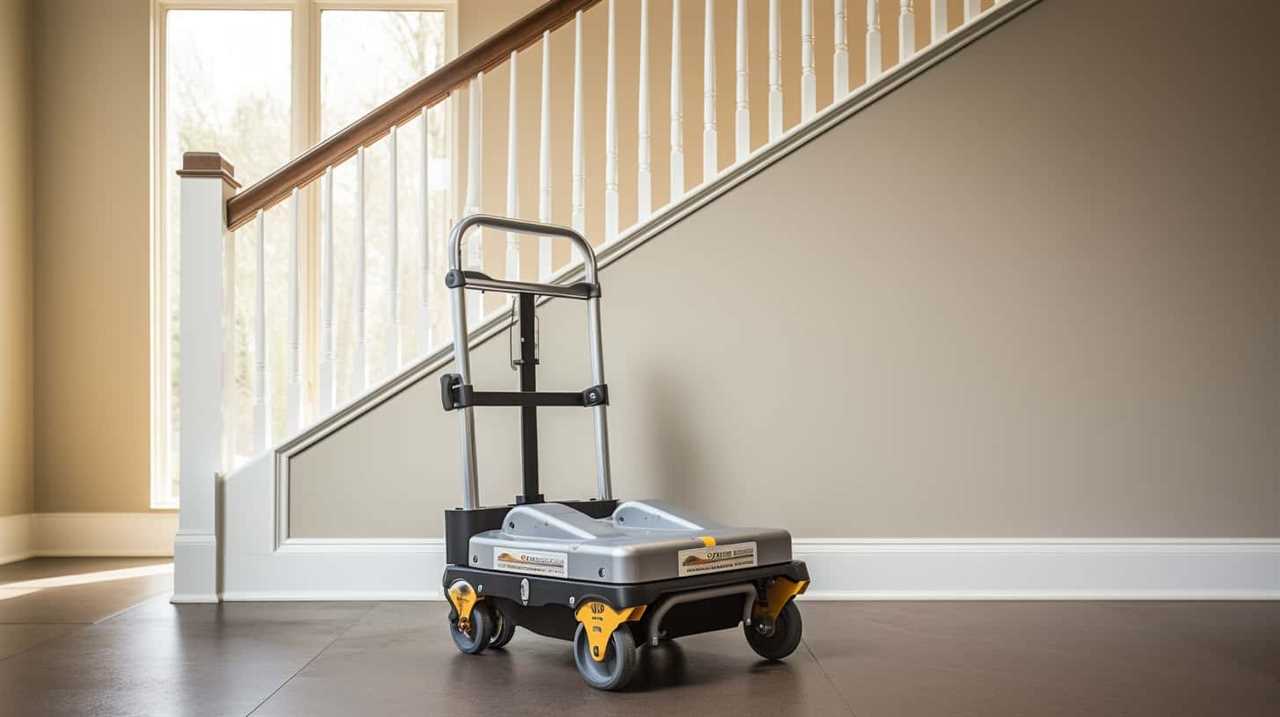
Customizable Brewing Options
Exploring the customizable brewing options of our Wi-Fi enabled smart coffee maker, we can create a personalized coffee experience with ease. With its remote brewing capabilities, this innovative kitchen gadget brings convenience and functionality to a whole new level.
Here’s what you can expect from our customizable brewing options:
- Adjustable Strength: Tailor the strength of your coffee to suit your taste preferences. Whether you prefer a bold and robust brew or a milder flavor, our smart coffee maker allows you to easily adjust the strength settings.
- Multiple Brewing Styles: From espresso to cappuccino, our coffee maker offers a variety of brewing styles. Experiment with different options to create your perfect cup of coffee.
With these customizable brewing options, you have complete control over your coffee-making process. Indulge in your favorite coffee creations and elevate your home brewing experience to a professional level. The possibilities are endless with our Wi-Fi enabled smart coffee maker.
Smart Food Scale With Recipe App Integration
One essential smart kitchen gadget that every home chef needs is a food scale that seamlessly integrates with recipe apps. This innovative device not only helps with portion control but also allows for accurate recipe tracking. With the integration of a recipe app, you can easily measure ingredients and keep track of your recipe progress all in one place.
Gone are the days of manually measuring ingredients with measuring cups and spoons. A smart food scale takes the guesswork out of cooking by providing precise measurements for ingredients. This ensures that your recipes come out perfectly every time. Whether you’re following a recipe from a cookbook or experimenting with your own creations, a food scale with recipe app integration is an invaluable tool in the kitchen.
The recipe tracking feature of this smart food scale allows you to keep track of the ingredients you have used and the ones you still need. It eliminates the need to manually cross off ingredients as you go, saving you time and preventing any missed or duplicated ingredients. This feature is especially helpful when cooking complex dishes with multiple components.
In addition to recipe tracking, a smart food scale with recipe app integration also provides portion control. It helps you measure the exact amount of each ingredient, ensuring that you’re following the recipe accurately and maintaining consistency in taste and texture. This is particularly useful for those who are watching their calorie intake or following specific dietary guidelines.
Smart Sous Vide Precision Cooker
Let’s dive into the next essential smart kitchen gadget: the smart sous vide precision cooker. This innovative device takes precision cooking to a whole new level. With its remote temperature control and cooking time optimization features, it revolutionizes the way you cook.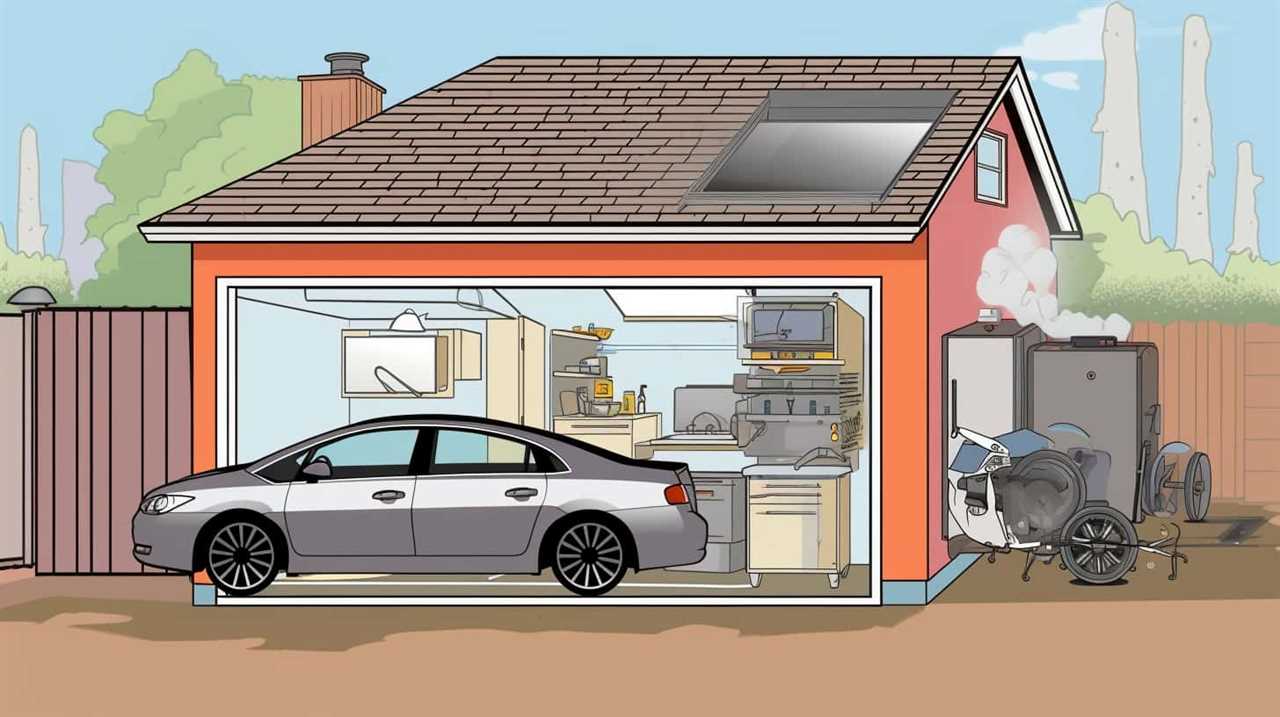
Imagine being able to control the temperature of your sous vide cooker from anywhere in your home. Whether you’re in the living room, taking care of other tasks, or simply relaxing on the couch, you can easily monitor and adjust the temperature with just a few taps on your smartphone. No more rushing back and forth to the kitchen to make sure everything is cooking perfectly.
But that’s not all. The smart sous vide precision cooker also helps optimize cooking times. By precisely controlling the water temperature and circulating it evenly around your food, it ensures that your ingredients are cooked to perfection every time. This means no more guesswork or overcooking. With the smart sous vide precision cooker, you can achieve restaurant-quality results in the comfort of your own kitchen.
Mastering the art of sous vide cooking has never been easier with this smart gadget. Say goodbye to the hassle of traditional cooking methods and embrace the convenience and precision of the smart sous vide precision cooker. Elevate your culinary skills and impress your guests with perfectly cooked dishes that will leave them wanting more.
Automated Stirrer for Hands-Free Cooking
An automated stirrer is an essential kitchen gadget that every home chef needs for hands-free cooking. This innovative device takes the hassle out of stirring, allowing you to focus on other tasks while your food is being perfectly mixed. Whether you’re making a sauce, soup, or a delicious risotto, the automated stirrer ensures even heat distribution and prevents sticking or burning.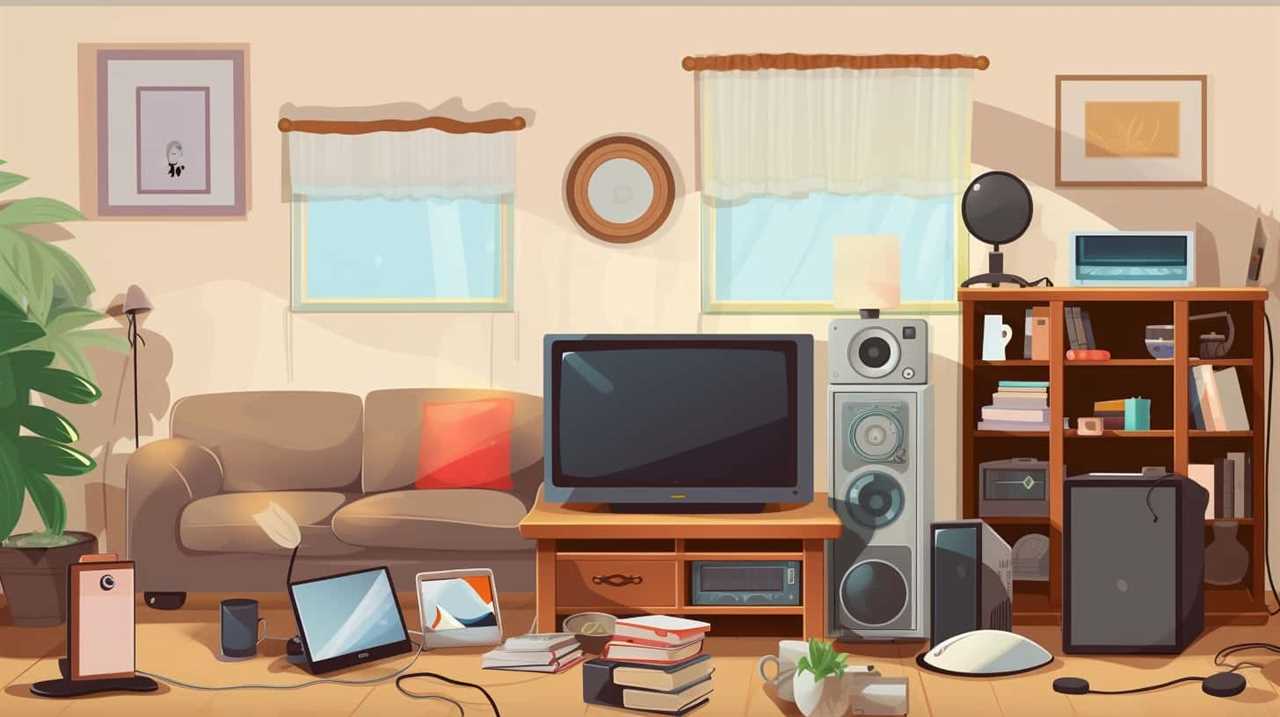
One popular option is the automated whisk, specifically designed for hands-free baking. With adjustable speed settings, it can effortlessly mix ingredients for cake batter, whipped cream, or meringues. Imagine being able to step away from the mixing bowl and let the whisk do all the work!
For those looking to take automation to the next level, a robotic chef for meal preparation is the ultimate kitchen companion. These advanced devices can chop, stir, and even cook your meals from start to finish. With pre-programmed recipes and precise temperature control, you can trust the robotic chef to create restaurant-quality dishes with minimal effort.
Investing in an automated stirrer or a robotic chef won’t only save you time and effort but also elevate your cooking game to the next level. Say goodbye to endless stirring and hello to hands-free cooking mastery!
Smart Air Fryer With Programmable Settings
Now let’s talk about the Smart Air Fryer with programmable settings.
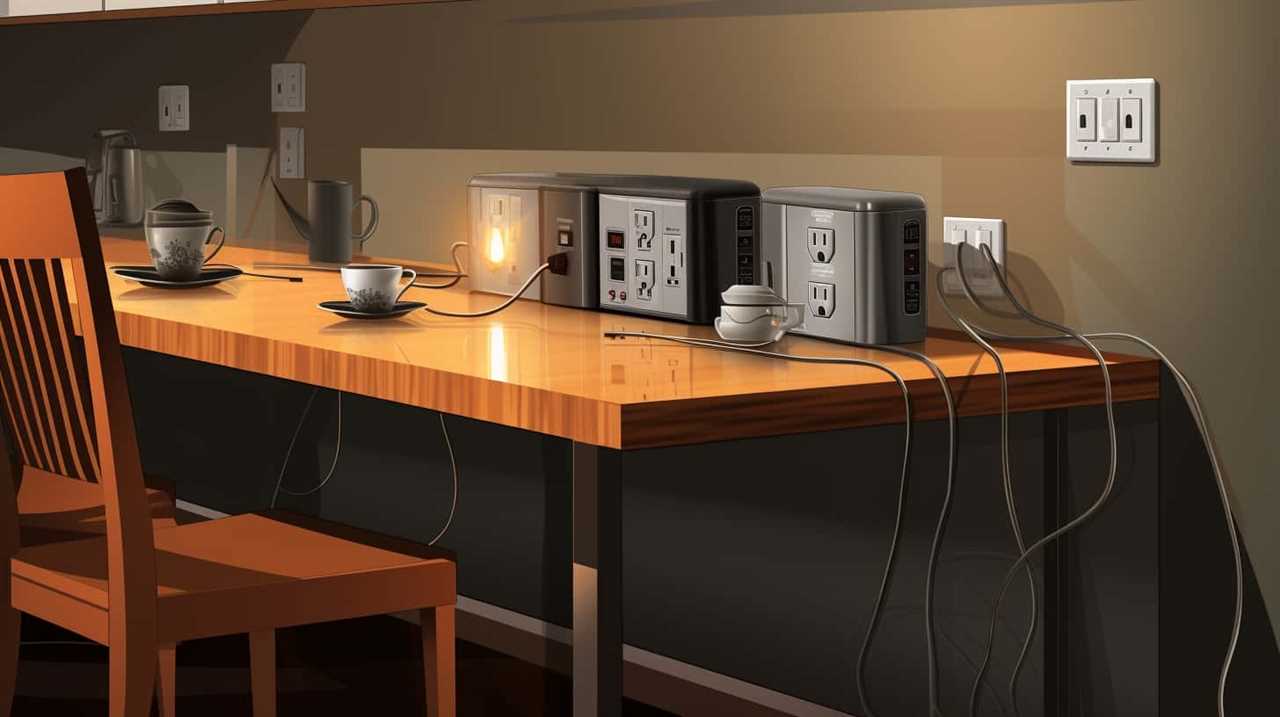
This innovative kitchen gadget is a game-changer for home chefs looking to save time and enhance their cooking versatility.
With its time-saving cooking features and customizable settings, you can easily achieve crispy, delicious results without the need for excessive oil or complicated recipes.
Time-Saving Cooking Features
We love how our smart air fryer with programmable settings saves us time in the kitchen. With its automated meal planning feature, we can easily schedule our meals for the week and let the air fryer do the rest. It’s like having our own personal chef!
Additionally, the smart air fryer is compatible with smart meal delivery services, allowing us to receive pre-portioned ingredients directly to our doorstep. This means less time spent at the grocery store and more time doing what we love – cooking delicious meals.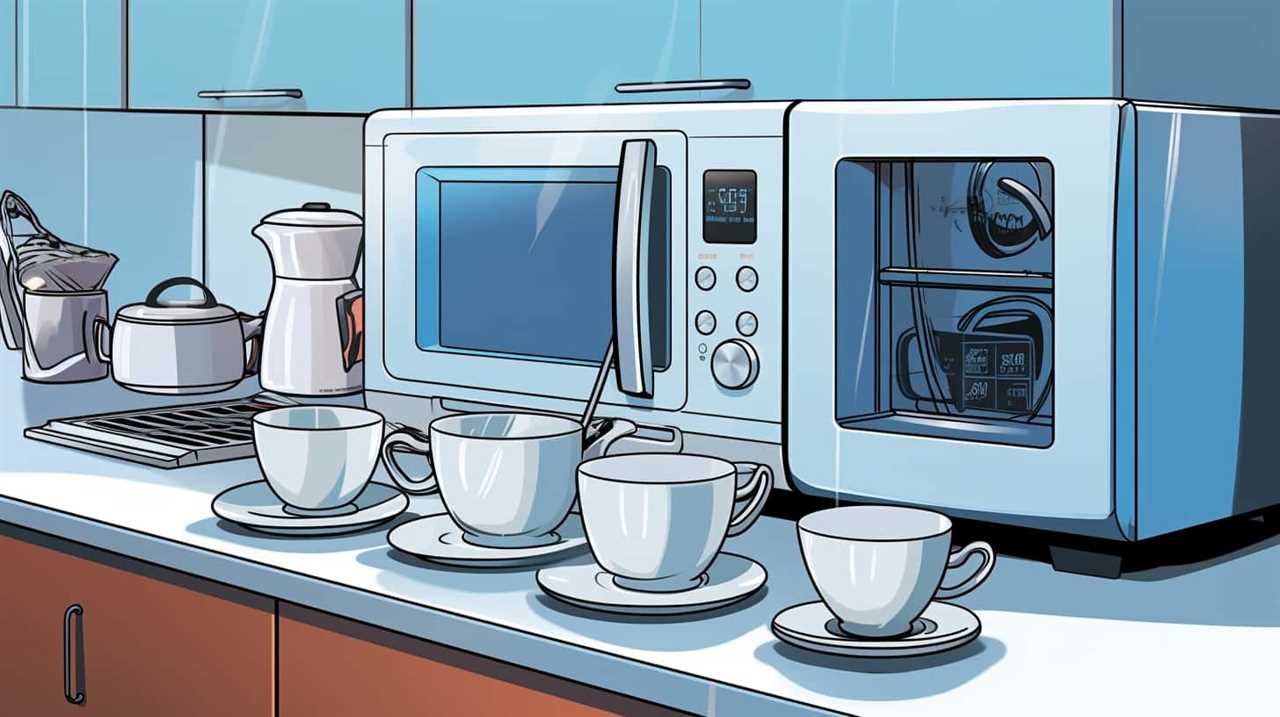
The programmable settings also ensure that our food is cooked to perfection every time, eliminating the need for constant monitoring.
Thanks to this incredible kitchen gadget, we can now enjoy convenient and time-saving cooking without compromising on taste and quality.
Enhanced Cooking Versatility
Our smart air fryer’s programmable settings enhance our cooking versatility. With these advanced features, we can achieve cooking efficiency and explore a wide range of advanced culinary techniques.
The programmable settings allow us to adjust the temperature and cooking time precisely, ensuring that our food is cooked to perfection every time. We can experiment with different cooking methods, from air frying to baking, roasting, and even dehydrating.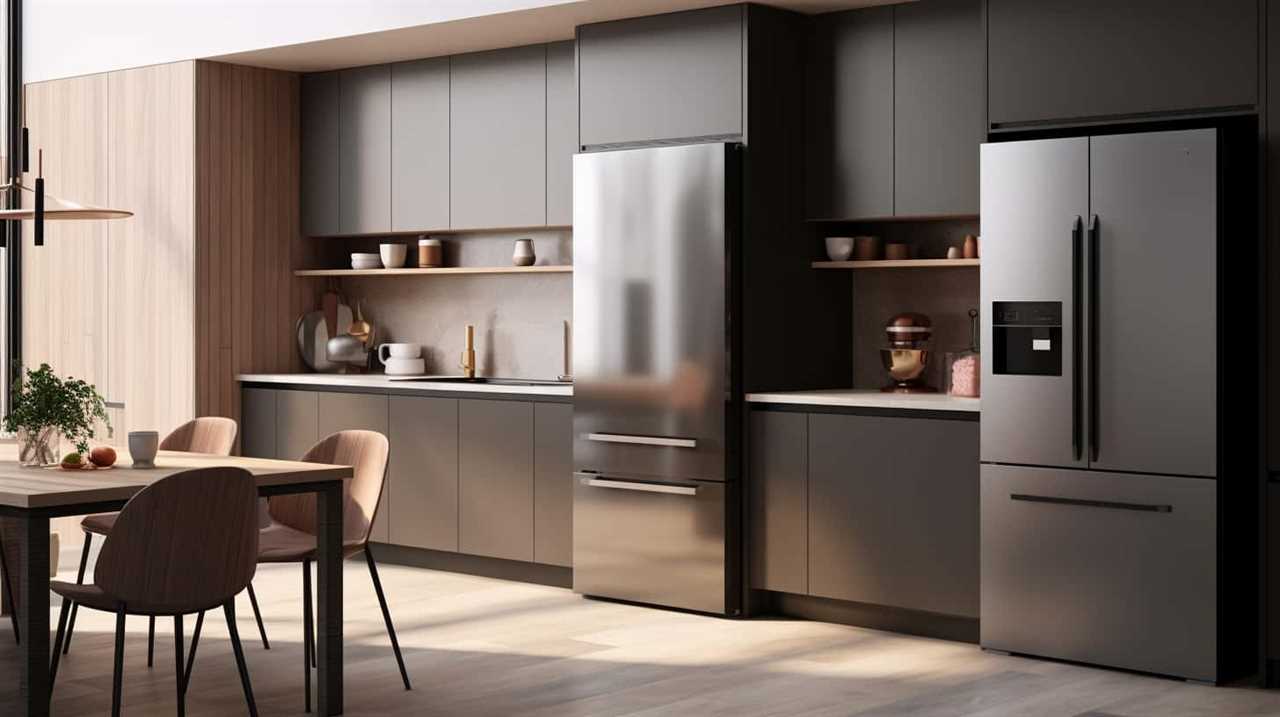
This versatility opens up a world of possibilities in the kitchen, allowing us to create healthier versions of our favorite fried foods or explore new recipes that require specific cooking techniques. Whether we want to cook crispy chicken wings, bake a batch of cookies, or even make homemade beef jerky, our smart air fryer with programmable settings is a must-have tool for any home chef looking to elevate their culinary skills.
Wi-Fi Connected Smart Blender
To streamline our kitchen experience, we incorporated a Wi-Fi connected smart blender into our culinary routine, allowing us to effortlessly blend ingredients with just a few taps on our smartphones. The benefits of blending remotely are numerous, and the integration of Wi-Fi connectivity in kitchen appliances has revolutionized the way we prepare our meals.
Here are some key advantages of this innovative gadget:
- Convenience: With a Wi-Fi connected smart blender, we can control and monitor the blending process from anywhere in our home. Whether we’re in the living room or outside in the garden, we can easily adjust the speed and duration of the blending to achieve the desired consistency.
- Time-saving: Gone are the days of standing by the blender, constantly checking and adjusting the settings. With the Wi-Fi connectivity feature, we can set the blender to start at a specific time, ensuring that our ingredients are perfectly blended when we’re ready to use them.
- Recipe suggestions: Many smart blenders come with companion apps that offer a wide range of recipes and blending techniques. These apps provide step-by-step instructions and even suggest ingredient combinations based on our preferences, making it easier than ever to experiment with new flavors and textures.
- Customization: Wi-Fi connected smart blenders allow us to save our favorite blending settings, creating a personalized library of recipes that can be accessed with a simple tap on our smartphones. This level of customization ensures consistency in our cooking and allows us to recreate our favorite blends effortlessly.
The integration of Wi-Fi connectivity in kitchen appliances, such as the smart blender, has undoubtedly enhanced our culinary experience. With the ability to blend remotely, save time, access recipe suggestions, and personalize our blending settings, this gadget has become an indispensable tool in our kitchen.
Smart Pressure Cooker With Multiple Cooking Modes
For maximum versatility in the kitchen, we rely on a smart pressure cooker with multiple cooking modes. This innovative kitchen gadget takes the guesswork out of pressure cooking by offering a range of preset cooking modes, each designed to deliver perfect results for different types of dishes. Whether you’re in the mood for a hearty stew, a tender roast, or a flavorful risotto, this smart pressure cooker has got you covered.
With its multiple cooking modes, you can easily select the perfect setting for your desired dish. From high-pressure mode for quick cooking, to low-pressure mode for delicate foods, this smart pressure cooker adapts to your cooking needs. It also offers modes for sautéing, steaming, and even yogurt making, giving you the ability to create a wide variety of dishes with just one appliance.
Not only does this smart pressure cooker offer convenience and versatility, but it also comes with advanced features that make cooking even easier. With its programmable timer and delay start function, you can set it to start cooking at a specific time, allowing you to come home to a delicious meal. Some models even come with built-in sensors that automatically adjust the cooking time and temperature to ensure perfect results every time.
Smart Slow Cooker With App-Controlled Features
When it comes to convenience in cooking, a smart slow cooker with app-controlled features is a game-changer. With the ability to control cooking settings and monitor progress right from your smartphone, meal preparation becomes a breeze.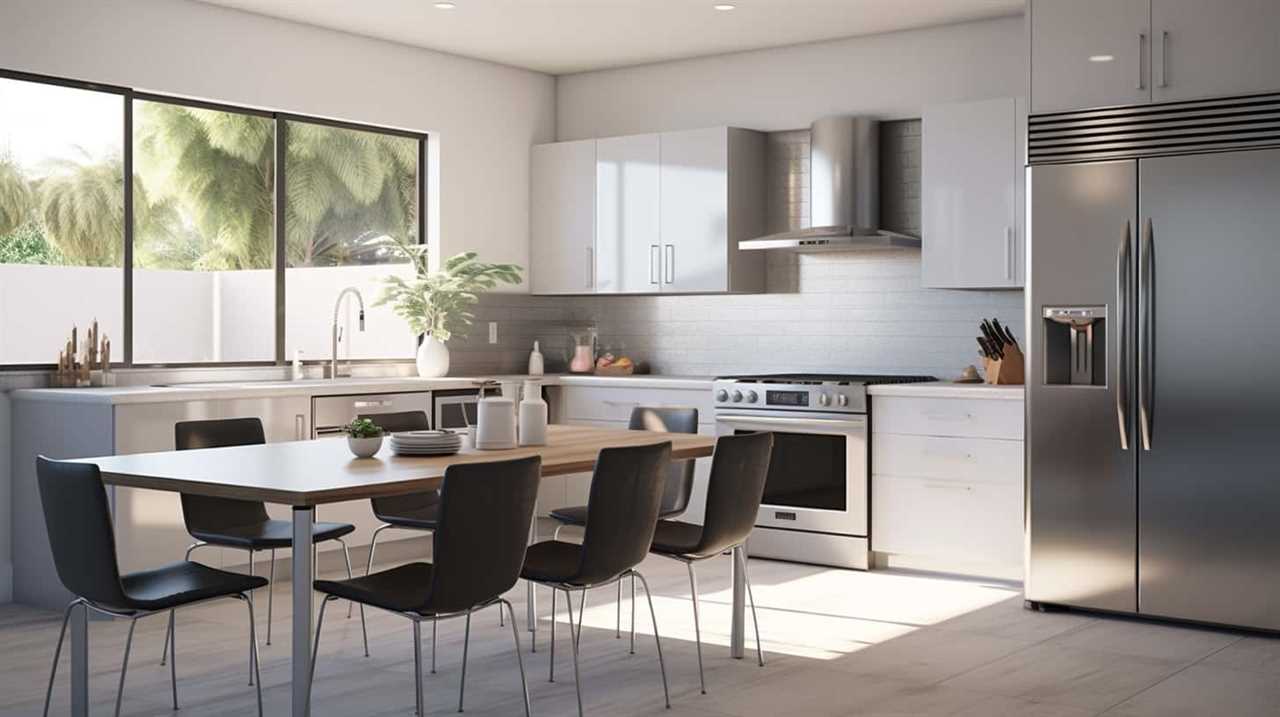
Not only does this save valuable time, but it also ensures enhanced cooking precision, allowing you to achieve perfect results every time.
App-Controlled Convenience for Cooking
With the use of an app-controlled smart slow cooker, we can easily enhance our cooking experience in the kitchen. This innovative gadget allows us to have app controlled meal delivery, ensuring that our meals are cooked to perfection even when we’re not in the kitchen.
The convenience of being able to monitor and control our slow cooker from anywhere using our smartphones is a game-changer. Additionally, this smart kitchen gadget contributes to smart kitchen organization by allowing us to plan our meals in advance and set timers remotely.
Imagine coming home to a perfectly cooked meal, with the aroma welcoming you at the door. This app-controlled convenience takes cooking to a whole new level, making it easier and more enjoyable for home chefs.
Now, let’s move on to the next section about time-saving meal preparation.
Time-Saving Meal Preparation
After experiencing the convenience of app-controlled meal delivery with our smart slow cooker, our time-saving meal preparation is taken to a new level. With the help of smart meal planning and efficient kitchen organization, we can now save significant amounts of time in the kitchen.
Our smart slow cooker comes with app-controlled features that allow us to monitor and control the cooking process from anywhere. We can easily adjust the temperature, cooking time, and even receive notifications when the meal is ready. This not only saves us time, but also ensures that our meals are cooked to perfection.
Additionally, the smart meal planning feature helps us plan our meals in advance, making grocery shopping and meal preparation more efficient. With these app-controlled features, we can now enjoy delicious homemade meals without spending hours in the kitchen.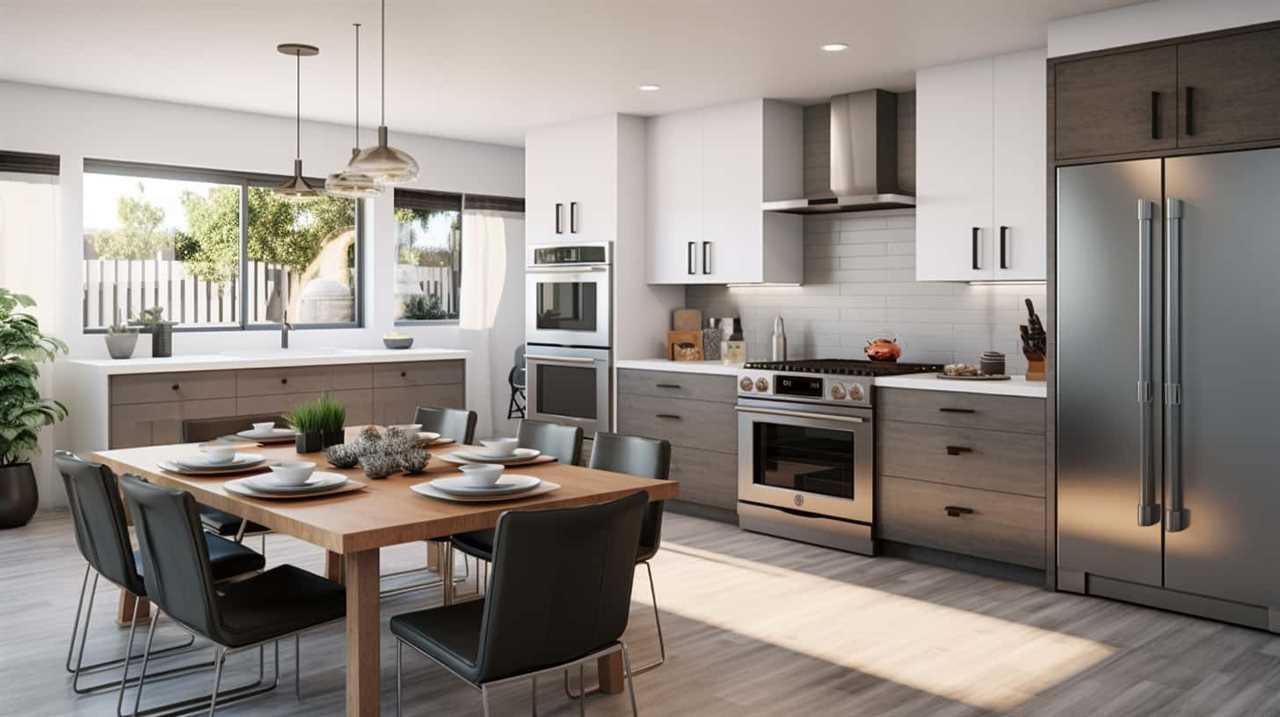
Enhanced Cooking Precision
Our smart slow cooker’s app-controlled features allow us to achieve enhanced cooking precision. With the ability to control the cooking temperature with pinpoint accuracy, we can ensure that our recipes turn out perfectly every time.
The app provides us with a range of cooking temperatures to choose from, allowing us to select the ideal setting for each dish. Whether we’re slow cooking a tender roast or simmering a flavorful soup, the smart slow cooker ensures that the temperature stays consistent throughout the entire cooking process.
This level of control not only guarantees recipe accuracy but also allows us to experiment and fine-tune our favorite dishes to perfection. With the app-controlled features of our smart slow cooker, we can elevate our cooking skills to a whole new level.
Frequently Asked Questions
How Do I Connect My Smart Refrigerator to My Home Wi-Fi Network?
Connecting a smart refrigerator to the home Wi-Fi network is a common concern for many users. In this blog post, we’ll guide you through the process and provide step-by-step instructions to ensure a seamless connection.
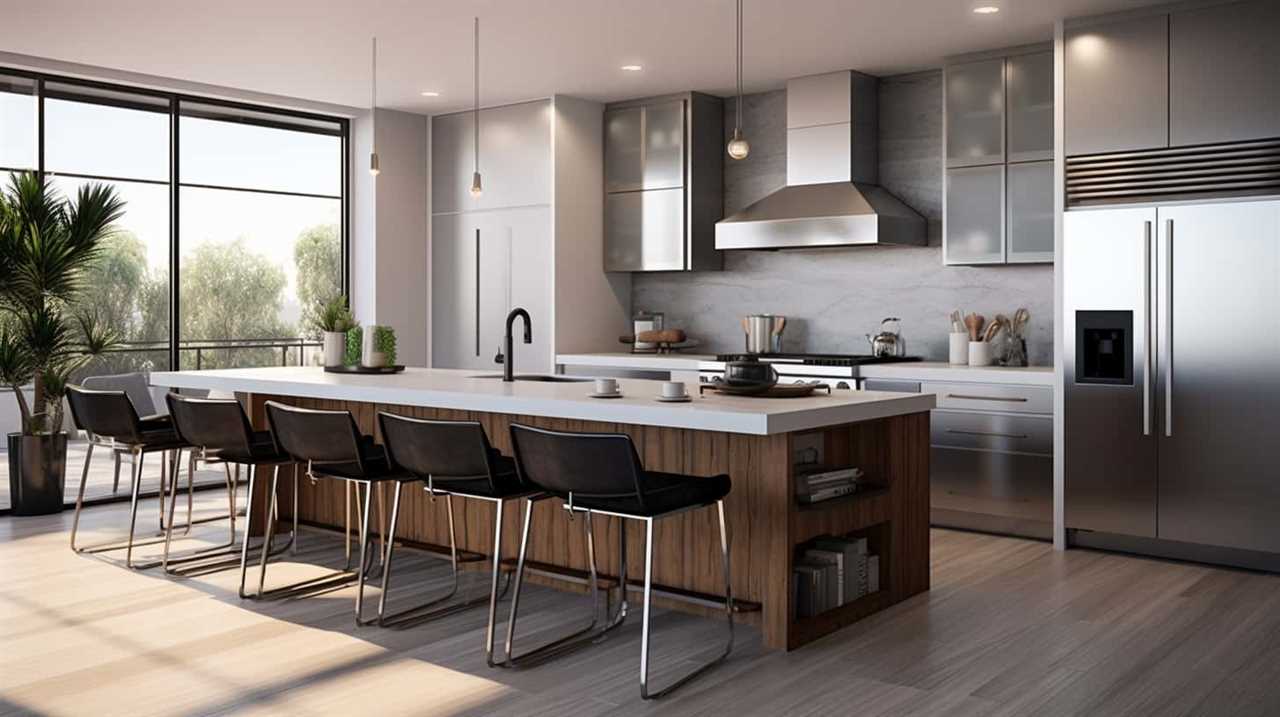
First, make sure your refrigerator is powered on and within range of your Wi-Fi router.
Then, access the settings menu on your refrigerator, navigate to the Wi-Fi section, and select your home network.
Enter your Wi-Fi password when prompted, and voila! Your smart refrigerator is now connected to your home Wi-Fi network.
Can the Voice-Controlled Smart Oven Be Controlled Remotely Through a Smartphone App?
Yes, the voice-controlled smart oven can be controlled remotely through a smartphone app.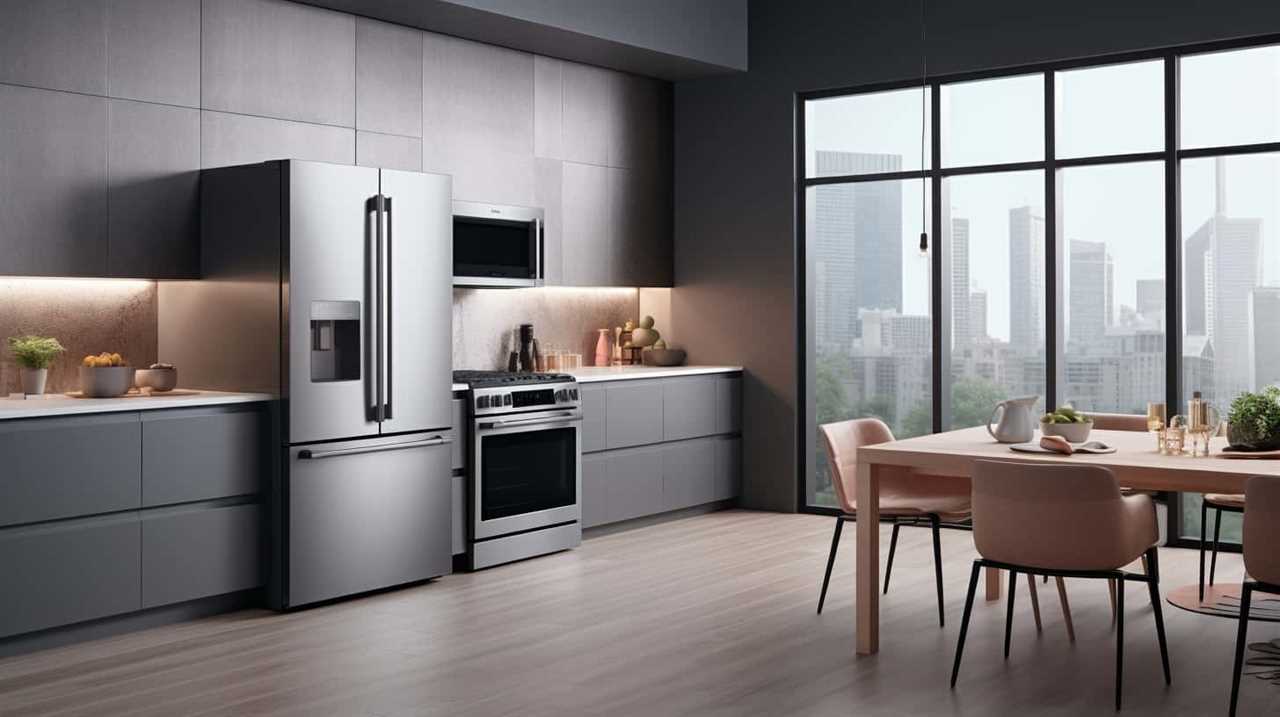
Smart kitchen appliances, such as voice-controlled smart ovens, are revolutionizing the way we cook and making our lives easier.
With the smartphone app, you can preheat the oven, adjust the temperature, and set timers from anywhere.
This feature is especially handy for busy home chefs on the go.
Upgrade your kitchen gadgets with a voice-controlled smart oven for complete control at your fingertips.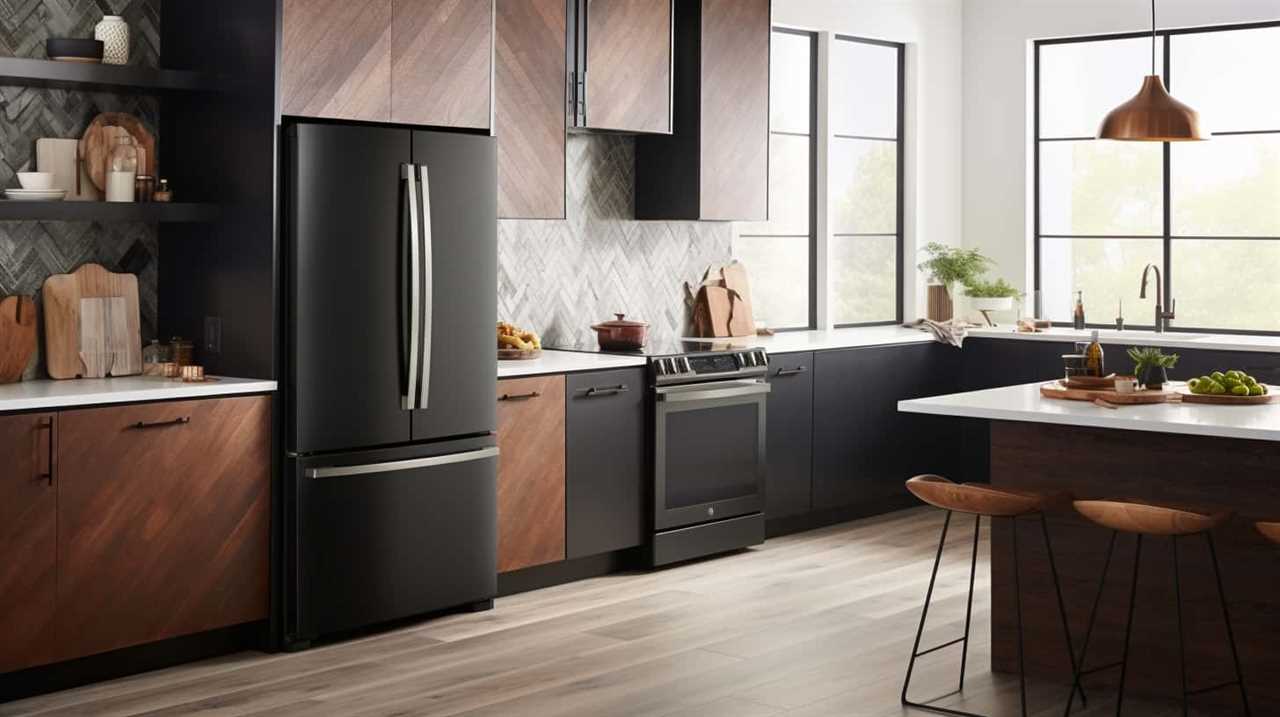
Can the Smart Coffee Maker Be Programmed to Brew Coffee at Specific Times?
Yes, programmable coffee makers can be a game-changer for every home chef. With the ability to schedule coffee brewing at specific times, you can wake up to the rich aroma of freshly brewed coffee, ready to kickstart your day.
Imagine the convenience of having your favorite cup of joe waiting for you when you stumble into the kitchen. It’s a small yet significant luxury that can make mornings more enjoyable and efficient.
Does the Smart Food Scale Provide Nutritional Information for the Ingredients Being Weighed?
Yes, the smart food scale does provide nutritional information for the ingredients being weighed. This feature is incredibly helpful for home chefs who want to track their calorie intake or ensure they’re following specific dietary requirements.
The scale connects to a smartphone app that displays the nutritional data in a clear and easy-to-read format. However, it’s worth noting that the accuracy of the nutritional information may vary depending on the database used by the app.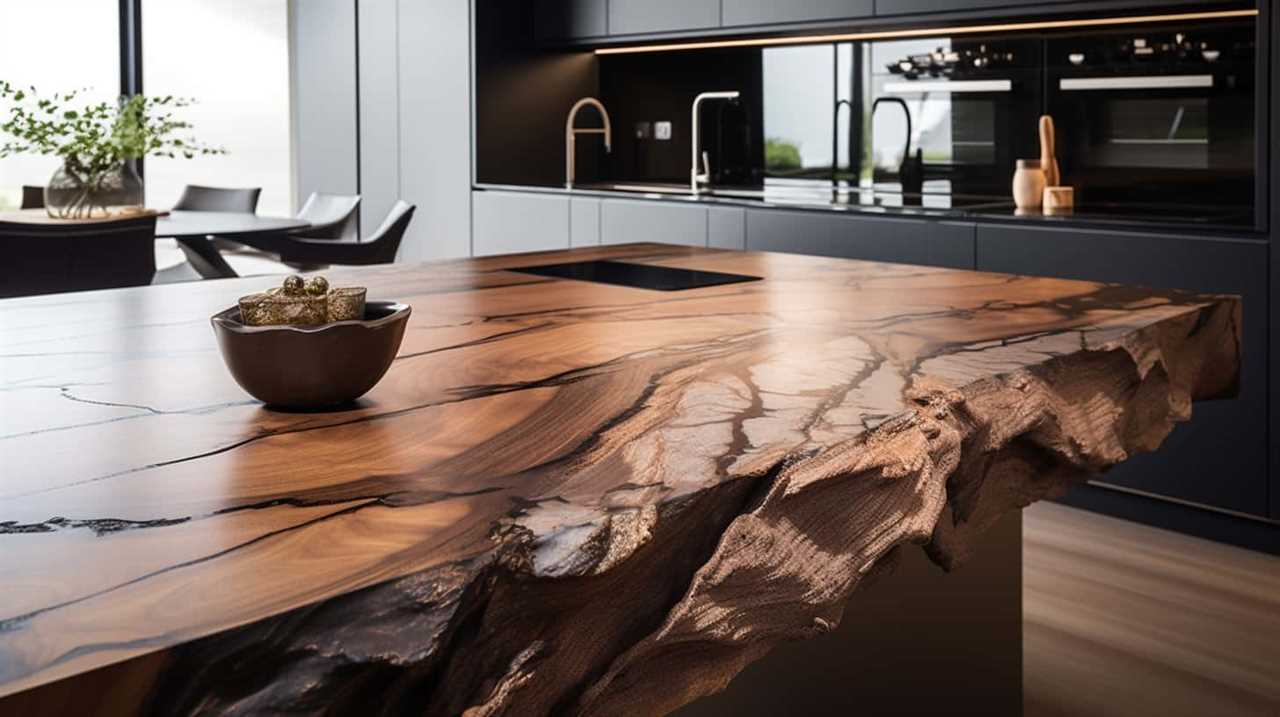
Can the Smart Pressure Cooker Be Used for Canning or Preserving Food?
Yes, the smart pressure cooker can be used for canning or preserving food.
It has a built-in canning function that ensures optimal pressure and temperature for safe preservation.
This feature allows us to can fruits, vegetables, and even meats with ease.
By using the smart pressure cooker for canning, we can extend the shelf life of our homegrown or homemade foods, preserving their freshness and flavor for longer periods.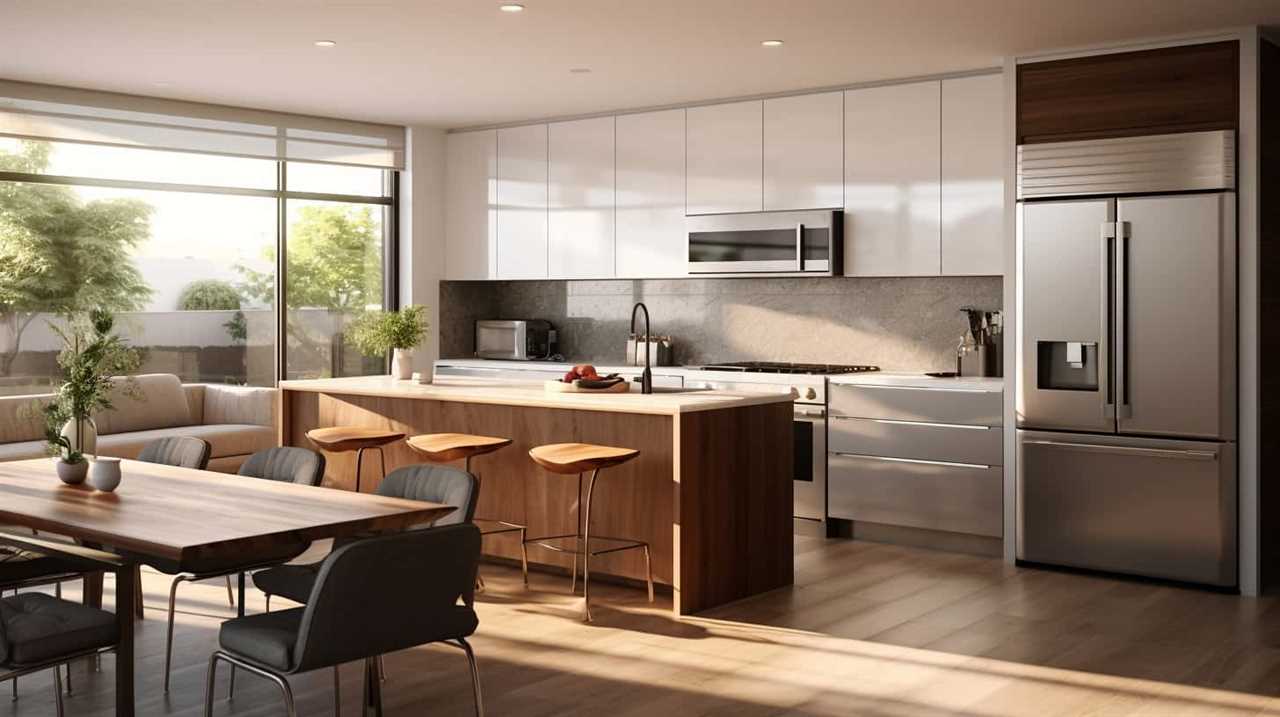
It’s a convenient and efficient way to stock up on homemade goodies.
What Makes These Kitchen Gadgets Essential for Home Chefs?
Every home chef knows the value of having the right tools in the kitchen. These smart kitchen gadgets for home chefs are essential for making cooking more efficient and enjoyable. From digital food scales to precision cookers, these gadgets help home cooks achieve professional results in their own kitchens.
Conclusion
In conclusion, these 10 smart kitchen gadgets are essential for every home chef.
With a smart refrigerator, voice-controlled oven, and Wi-Fi enabled coffee maker, cooking has never been easier.
The integration of recipe apps with a smart food scale and precision cooker ensures accurate and delicious results.
Additionally, programmable settings in the air fryer and blender, multiple cooking modes in the pressure cooker, and app-controlled features in the slow cooker take convenience to the next level.
Upgrade your kitchen with these smart devices and elevate your culinary experience.
- About the Author
- Latest Posts
Introducing Charles, the Editor in Chief at ByRetreat, whose passion for interior design and editorial excellence elevates every remote workspace to new heights. With his keen eye for detail, impeccable taste, and expertise in design, Charles brings a wealth of knowledge and creativity to the ByRetreat team.
As the Editor in Chief of a renowned lifestyle blog, Charles has honed his skills in curating captivating content and staying up-to-date with the latest trends in interior design. His deep understanding of aesthetics and the power of storytelling through design enables him to create remote workspaces that are not only visually stunning but also rich in personality and meaning.
-

 Vetted3 weeks ago
Vetted3 weeks ago15 Best Drip Irrigation Systems to Keep Your Garden Thriving
-

 Vetted2 days ago
Vetted2 days ago15 Best Foot Massagers for Neuropathy to Soothe Your Feet and Relieve Discomfort
-
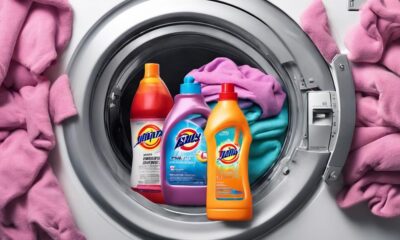
 Vetted1 week ago
Vetted1 week ago15 Best Sports Laundry Detergents for Keeping Your Activewear Fresh and Clean
-
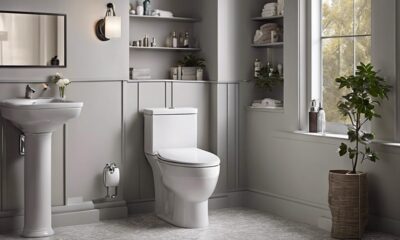
 Vetted1 week ago
Vetted1 week ago15 Best Tall Toilets for Seniors That Combine Comfort and Safety
-

 Vetted2 weeks ago
Vetted2 weeks ago15 Best Dish Scrubbers to Keep Your Kitchen Sparkling Clean
-

 Beginners Guides4 weeks ago
Beginners Guides4 weeks agoDesigning Your Retreat Center – Essential Tips
-
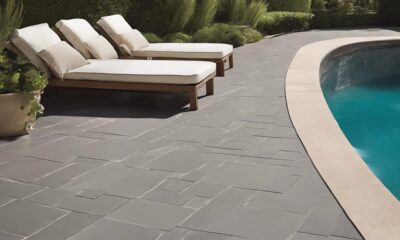
 Vetted4 weeks ago
Vetted4 weeks ago15 Best Tile Adhesives for Outdoor Use – Top Picks for Durable and Weather-Resistant Installations
-

 Beginners Guides4 weeks ago
Beginners Guides4 weeks agoAre Retreats Profitable





